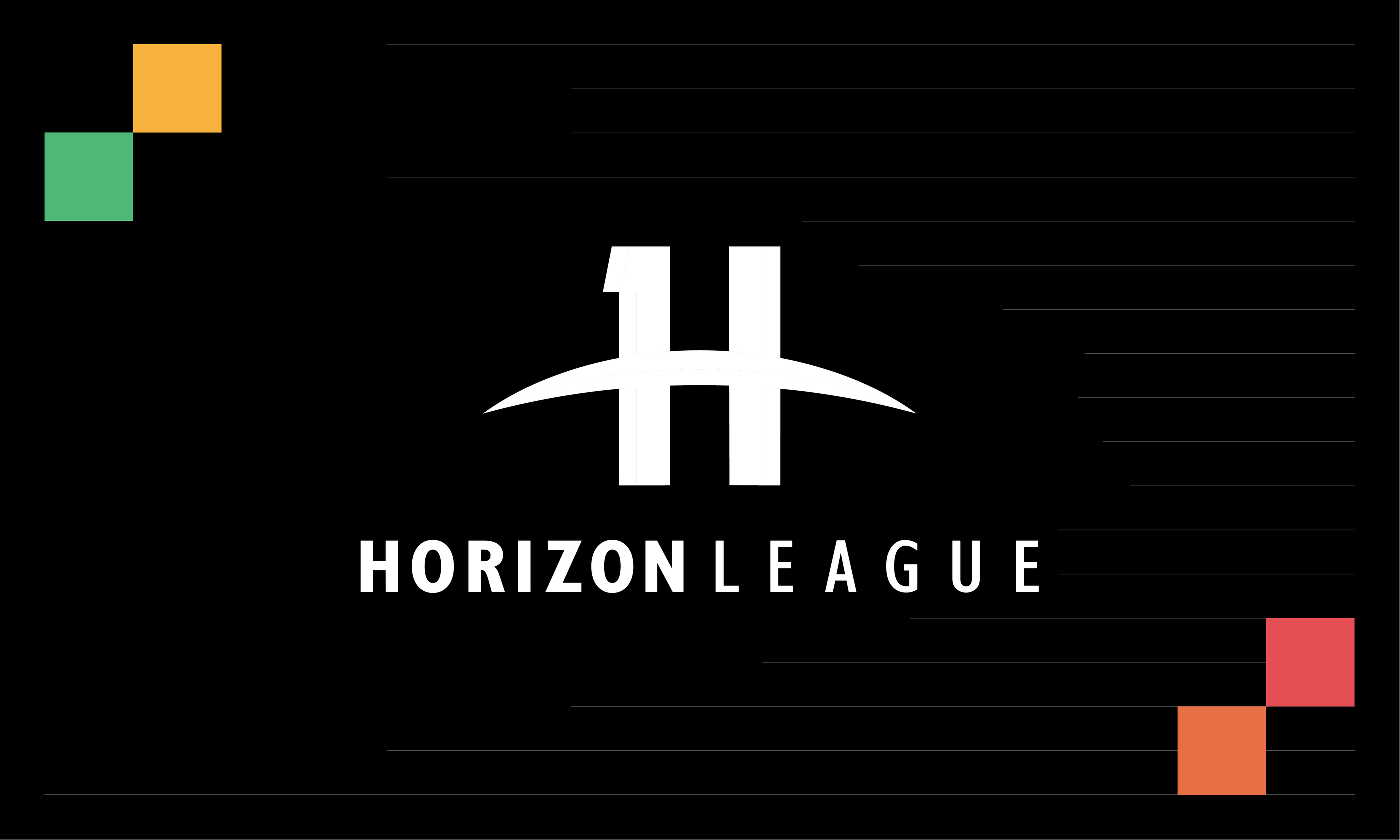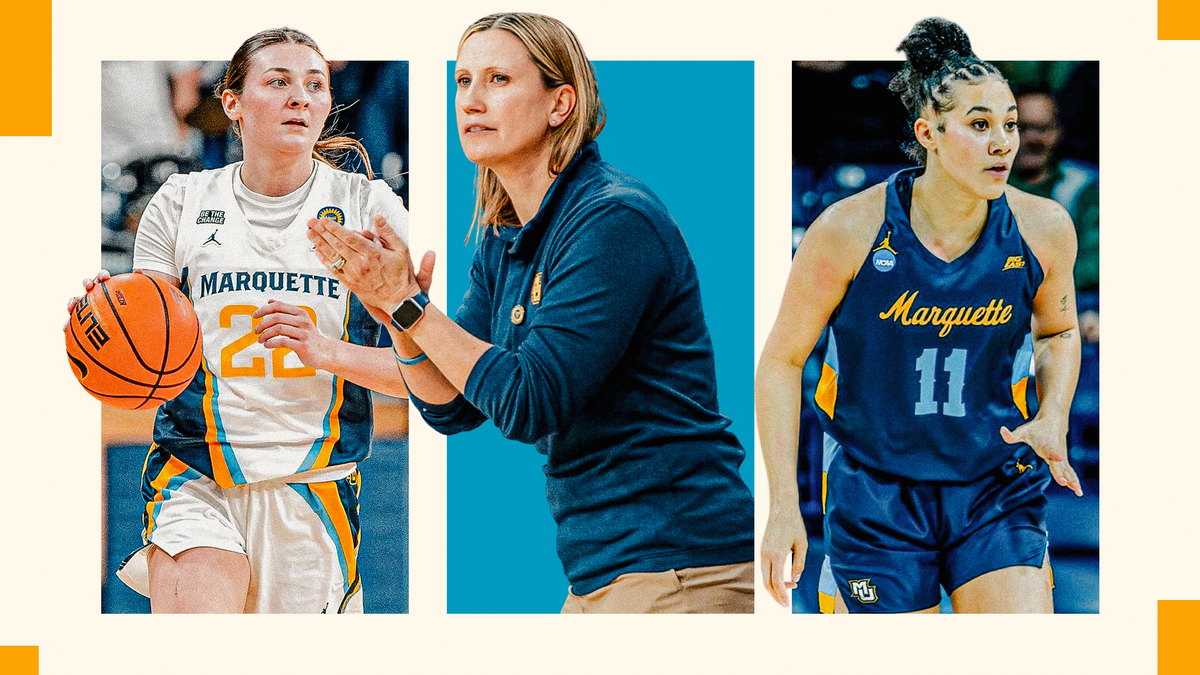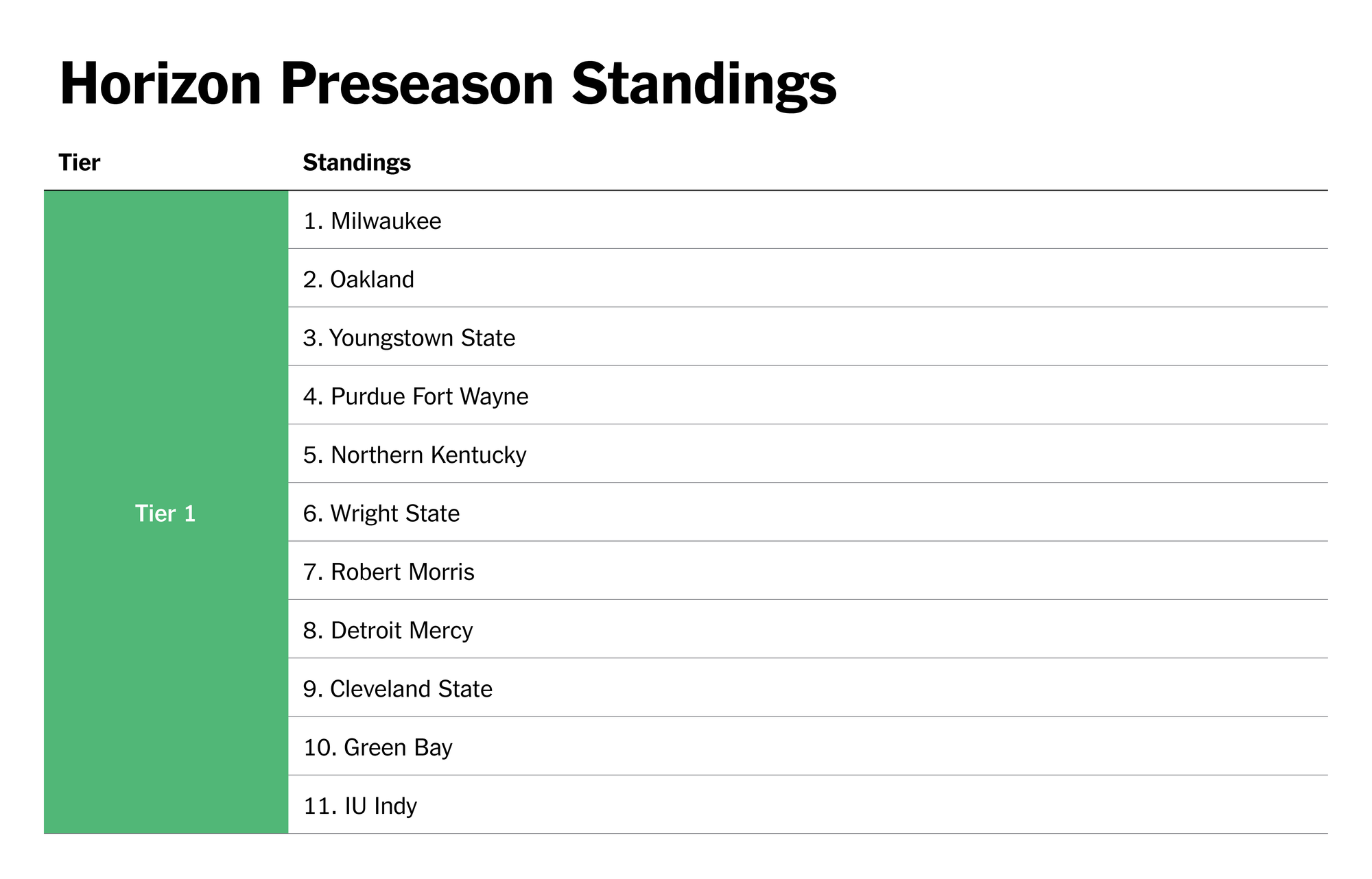
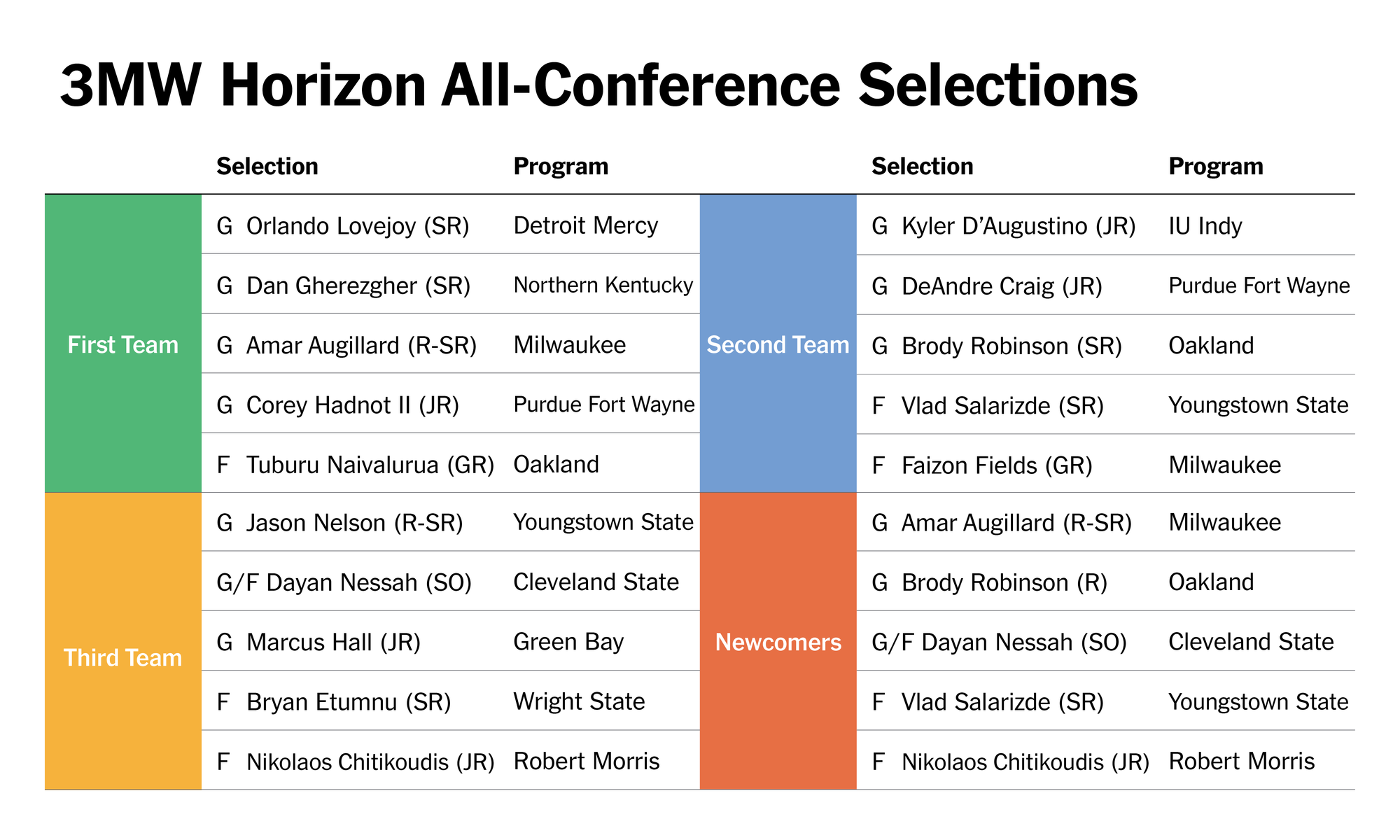
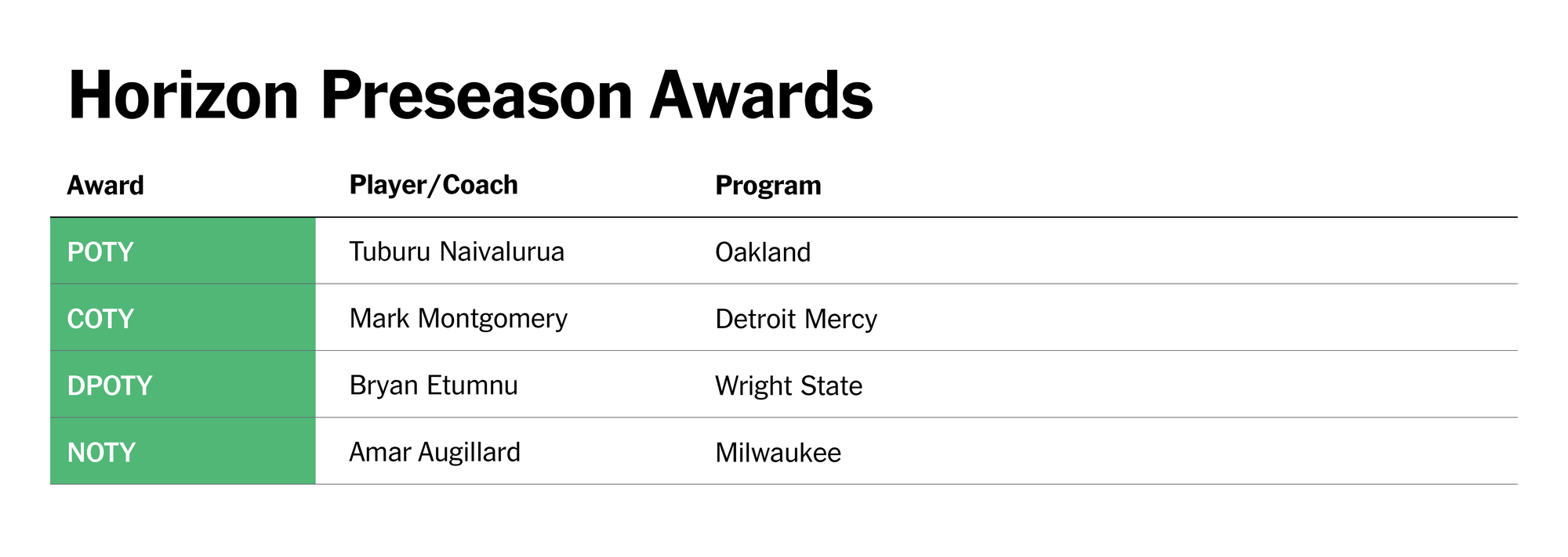
1) Milwaukee
Key Returners:
Faizon Fields, John Lovelace Jr.
Key Losses:
Themus Fulks, Jamichael Stillwell, Kentrell Pullian, AJ McKee, Erik Pratt, Darius Duffy
Key Newcomers:
Seth Hubbard, Amar Augillard, Sekou Konneh, Ned Renfree, Josh Dixon, Stevie Elam
Roster:
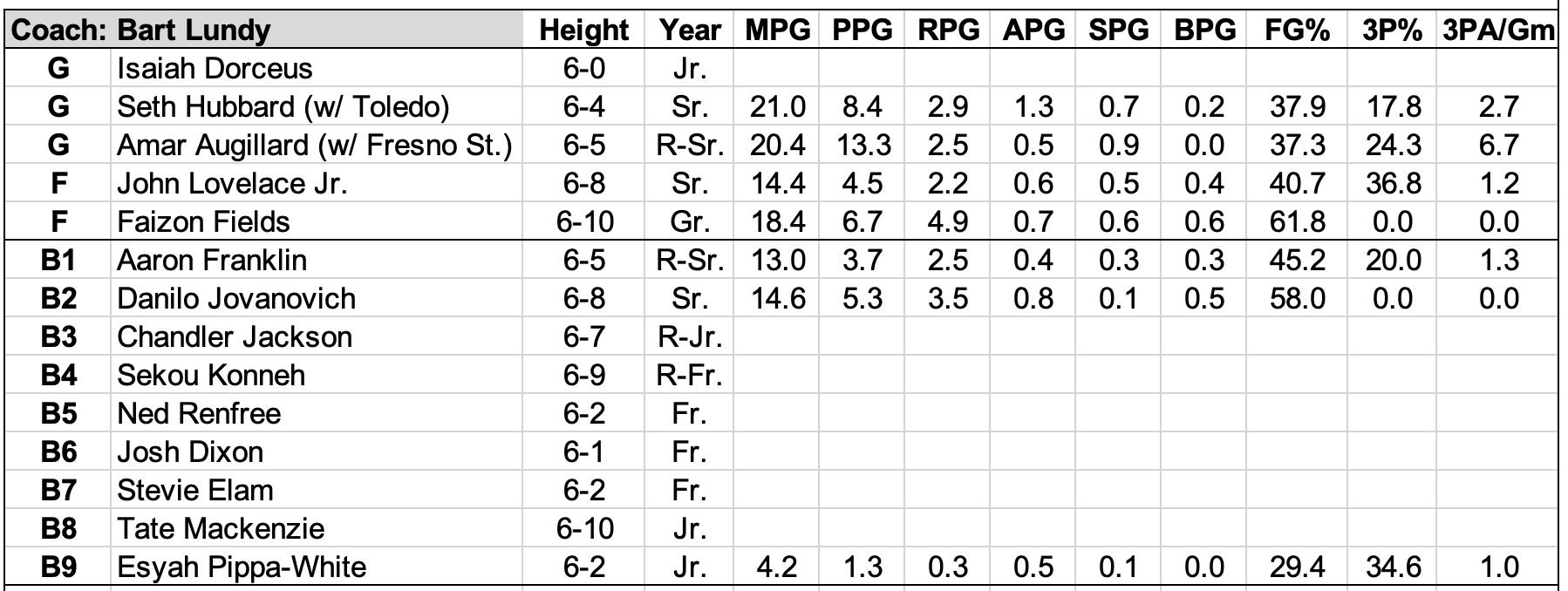
Reasons for Optimism:
At first glance, this roster construction looks like a harmonious blend between returners and newcomers. The four key incumbents are not only undervalued for various reasons (injuries, namely), but they’re proven contributors in complementary roles. While many programs are asking role players to step up as stars, Milwaukee won’t need that from the likes of John Lovelace Jr., Faizon Fields, Aaron Franklin or Danilo Jovanovich. Any leaps of that magnitude would simply be a bonus, as the hyper talented newcomer crop is expected to be the ‘stars’ on this season’s show.
To start, a clean bill of health may unlock the true ability of Fields, Jovanovich and Franklin. Fields is oozing with talent but a broken finger stunted his development last year. Jovanovich did an ankle and battled through a concussion, among other ailments, and Franklin was also on the shelf for nine games in the heart of the year.
Fields and Franklin are the swing dominoes this season. Fields is a prototypical 5-man with top end paint protecting potential while Franklin’s ‘power guard’ frame is perfect mold for Lundy’s guard centric system (he likes pace and space but also loves crashing the glass).
Speaking of power guards, Amar Augillard is a lab-created specimen of that prototype. A polarizing yet promising talent from Fresno, Augillard has ping-ponged from Western Illinois to Fresno now back to Milwaukee. He’s the epitome of a bucket getter. Armed with a beefy frame and an impressive shotmaking repertoire, Augillard can score anywhere on the floor.
The goal will be channeling what should be monster production into an efficient and winning impact. For one, it may help playing with teammates who aren’t point shaving. I'm also choosing to discount his 24% 3-point field goal percentage at Fresno last year before he was booted from the team. Augillard made 122 of 287 (42.5%) from downtown at Triton at the JUCO level the year prior.
Combo guard Seth Hubbard is a proper ancillary piece next to Augillard. Like Augillard, Hubbard’s ghastly shooting performance last season is more likely an outlier than trend - he’s a career 80% free throw shooter and made over 40% from long distance his first season at Western Michigan. Hubbard is another bigger guard and gritty rebounder, a trait Lundy holds in the highest regard from all five positions.
The other wildcard contributors are Chandler Jackson, Sekou Konneh and Tate Mackenzie. Finding active rebounders was important in the wake of Jamichael Stillwell’s departure, but Stillwell was a Dennis Rodman esque rebounder at this level last year.
Causes for Concerns:
Lundy eloquently broke down his two chief concerns with roster construction and how it influenced his portal attack this summer - the excerpt quote below is only a sliver of the good insights on the conference from Horizone Roundtable’s extensive league preview episode.
The first is 3-point shooting. Lundy’s team totally abandoned the long ball last year compared to his first two years, but that was largely out of necessity.
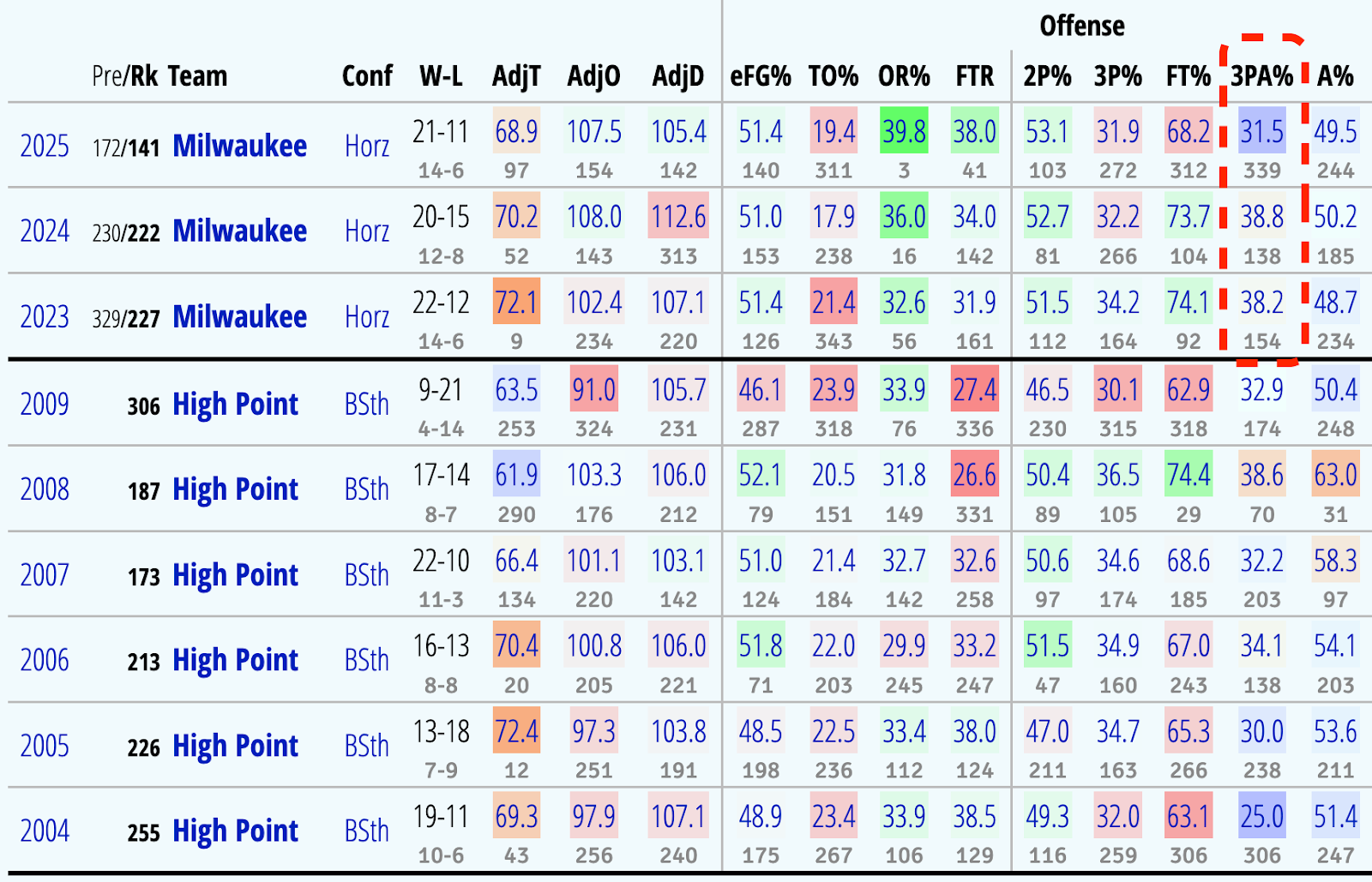
“That change in philosophy had to happen last year. We just couldn't shoot straight. What keeps me up at night is we haven't recruited enough shooting since I've been here. We were an elite rebounding team and a pretty good defensive team. But we only lost one game when we made over seven threes. I just think in college basketball, if you can't make the three, it makes it really difficult, and you can do all that other stuff right, but if you can't make enough threes, it's hard to overcome when other people are getting more points per shot than you are. So, we've tried to correct that.
I think this year we're for sure going to take a lot more. Hopefully, we make a lot more. Time will tell on that, but that was a focus.
The other focal point, which some may doubt given the signing of Augillard, was eliminating off the court or mental baggage:
We really focused on shooting in our recruiting, but our number one focus was character. I just think in this era of NIL and the portal, we've tried to get the best kids we can get. , early, we took some chances on guys, and some of it worked out, some of it didn't. But I think part of us not getting over the hump on championships has been small flaws in character and the shooting. So, we've tried to address those things.
Hey, when you grab 42% of your missed shots, it doesn’t really matter if you can’t make the first one - just go get the second or third one and stick it in. This overly simplistic description of the Panthers’ offense last year worked with Jamichael Stillwell. No one returning or coming in can emulate his dominance on the glass but expect the Panthers to still be in the upper half of the Horizon in rebounding rate, especially on the offensive end, and the defensive rebounding is where a healthy Fields will make a world of difference.
The other wrinkle to a Stillwell-less rebounding cheat code is the impact on the possession war. Milwaukee’s shaky ball security last season was largely rendered moot by the extra shots Stillwell and the rebounding brigade stole back on the offensive glass. It's fair to expect the Panthers to rebound at a worse clip than a year ago, so a steadier hand at point guard may be required to cut back on turnovers, and help keep the possession ledger in Milwaukee's favor.
The two names to note are Isaiah Dorceus and rookie Stevie Elam. Dorceus is one of five top-100 JUCO players debuting in the Horizon this season. Of nearly 200 eligible players last season at the D-I JUCO level, only 20 dudes posted an assist to turnover ratio better than 2.0.
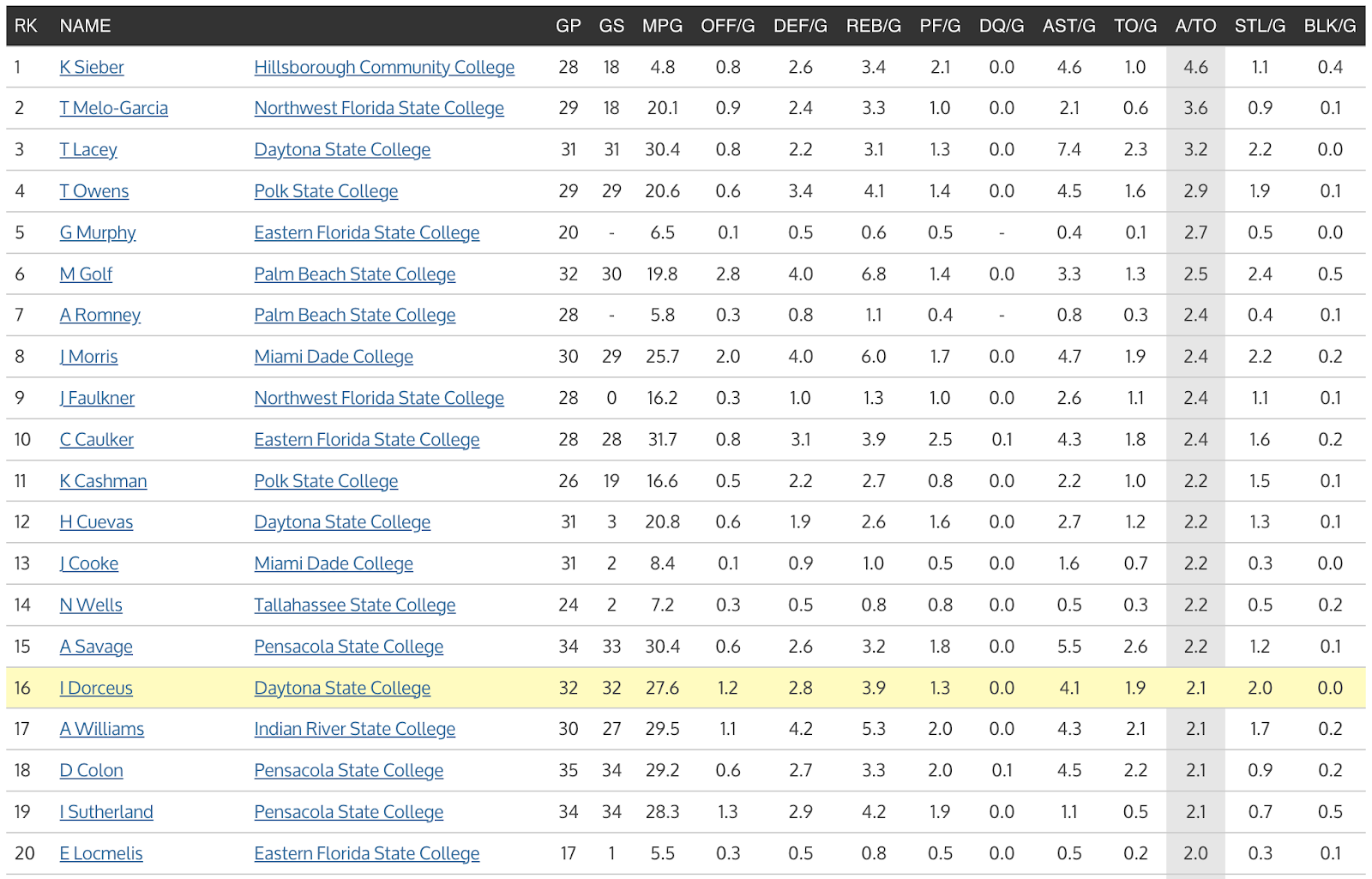
Of this esteemed 20 player group, Dorceus was one of only four to also average two or more steals a game.
As for Elam, well, he almost looks like a mini Augillard. A big body and crazy shotmaker, Elam looks like a 22-year old in his high school tape.
6’3 UW-Milwaukee freshman Stevie Elam is a legit scoring talent who’s entering his first year at the D1 level
— Arman Jovic (@PDTScouting) August 23, 2025
Averaged 25.6 PPG, 10 RPG, 4 APG as a senior in high school while shooting 38.6% from 3
Elam also averaged 25.3 PPG in NY2LA competition last summer while shooting… pic.twitter.com/9bfcaGTzdb
Bottom Line:
In terms of balancing internal continuity and development with an external infusion of upside, Lundy might have nailed it with this roster. He returns four legitimate contributors from a year ago, all of whom are high level role players capable of supplementing Aguillard, who is far and away the most unguardable weapon in this league.
2) Oakland
Key Returners:
Tuburu Naivalurua, Nassim Mashour
Key Losses:
Allen David Mukeba, DQ Cole, Isaiah Jones, Jaylen Jones (Oak), Malcolm Christie, Jayson Woodrich
Key Newcomers:
Brody Robinson, Isaac Garrett, Khoi Thurmon, Ziare Wells, Michael Houge, Brett White, Nate Deer
Roster:
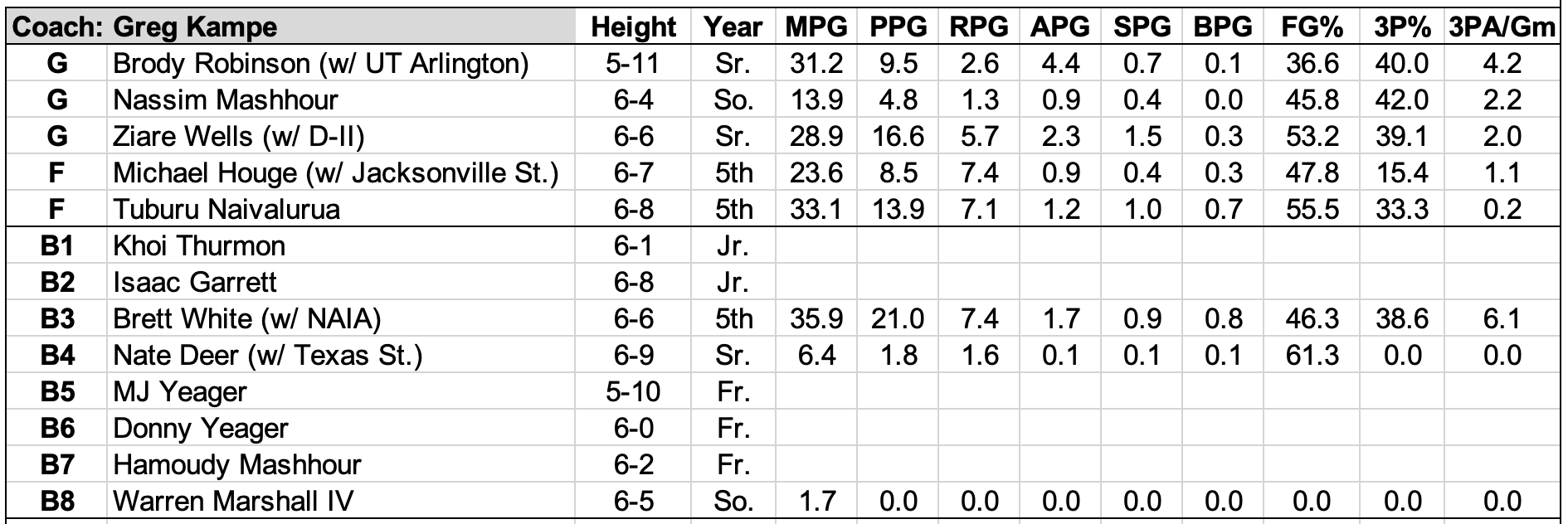
Reasons for Optimism:
Greg Kampe didn't mince words when gushing about his team's potential earlier this month:
“We've got a plethora of players I've never had in my coaching career. I've never had 10 guys where I've sat there and said, ‘I have to play all 10 guys’. Usually we have three or four really good guys, two or three guys have to play, and then you're hoping for six through 10. That's the life of a mid-major. But this year I feel I got 10 guys.”
Kampe pursued a point guard he believes is cut from the same cloth as many of his past great floor generals. Brody Robinson was a little erratic in his D-I debut at UT Arlington last year but he might round into a perfect mid major maestro under Kampe. Robinson's a little undersized but fast, smart, and skilled. He loves to push the pace in the open floor, so shooters will need to be shot ready at all times (paging Nassim Mashhour and Brett White).
The Grizz haven’t shot it well at all since COVID, save the special Jack Gohlke season two years ago. Kampe is a major proponent of the 3-point shot, and instills the utmost confidence in his players to pull the trigger from anywhere, anytime. If those triples finally fall this year, look out Horizon.
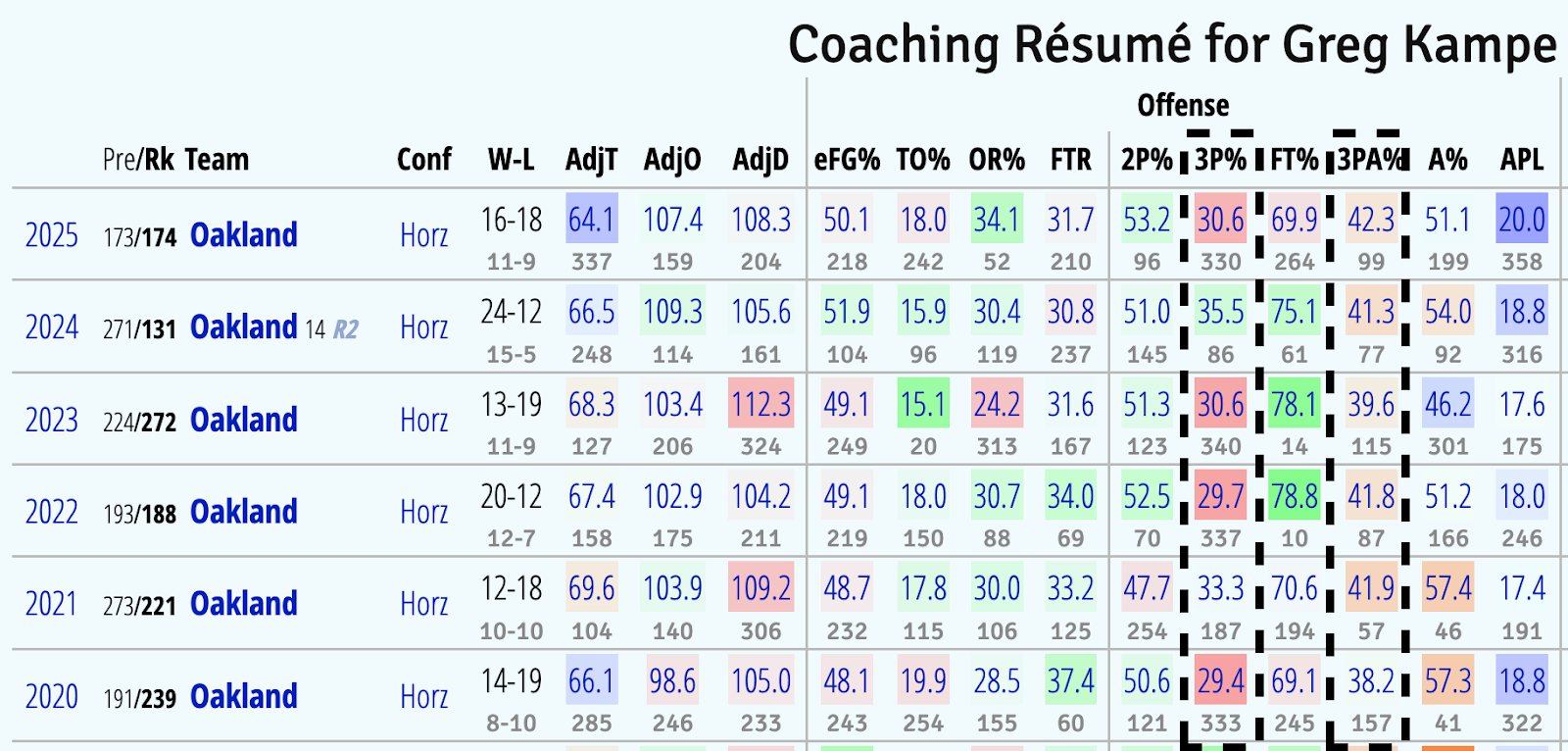
The luxury with this roster is that the Grizz can easily remedy cold shooting nights by dominating the offensive boards. Simply put, no team in the Horizon can stack up with this frontline on the glass.
Tuburu ‘Buru’ Naivalurua is the main man in the middle and prevailing frontrunner for Horizon League Player of the Year. Buru is 24/7 workhorse in the lane and on the glass, which is where he racks up the majority of his production. Buru is a little less dangerous as an isolation scorer and post up player but that’s where Isaac Garrett comes in.
The interior centerpiece of the nation’s best JUCO team a year ago, Garrett can score in a variety of ways: back to the basket in the post, as a pick-n-roll diver, and even as a slasher from the top of the key. There’s a world in which Garrett emerges as Oakland’s best player but his production might be somewhat capped by Buru’s presence. Collectively, it'll be a problem for Horizon foes:
Kampe is even bullish on Nate Deer, who may be an overqualified backup behind Buru and Garrett. With a minimal drop off from starter to reserve at the 5 position, foul trouble will be nothing more than a blip on the radar this year.
Causes for Concerns:
The problem Kampe faces is a good one to have. How to find minutes for the depth at his disposal. He inked two of the best JUCO players in the conference, neither of whom may be a day one starter.
For example, Khoi Thurmon is a powerful point guard and top-25 nationally ranked JUCO prospect - he would start on most Horizon teams tomorrow. Kampe must find a way to play Robinson and Thurmon together, an enticing dual point guard attack. However, featuring two smaller players at the top of the zone may not be optimal. However, Kampe is already devising a plan to slide Robinson off the ball when Thurmon comes in, a smart decision made possible by Brody’s shooting ability.
Kampe is always nervous with implementing his zone, especially with having to shuffle the deck on an annual basis. Their zone is so unique it doesn’t track with generic 2-3 or 1-3-1 zone principles, so any first year player will have a learning curve.
Ziare Wells and Michael Houge are the unsung heroes at the 3 and 4 respectively. Since it will be hard to keep both Buru and Garrett off the floor for large stretches, Houge will likely provide backup at the 4, akin to Deer’s role at the 5. However, Hogue’s per minute production could be monstrous. The Detroit native posted better rebounding rates on both offense and defense than Buru in a better league last year, to give an indication of how active he’ll be on the glass. Wells is a well rounded swiss army knife with a nice blend of offensive value as a floor spacer and defensive value due to his length.
Bottom Line:
I asked Kampe to fill in the blank to this sentence: “Oakland will be very good this year if___”.
His response? 1) point guard play, 2) shooting and 3) zone defense. With a dominant frontline as a sturdy bedrock, Kampe isn’t worried about ruling the paint with an iron fist. It comes down to his perimeter mix and how well they create and make shots, along with their ability to master the zone principles in an expedited fashion.
3) Youngstown St.
Key Returners:
Jason Nelson, Cris Carroll
Key Losses:
Nico Galette, EJ Farmer, Juwan Maxey, Ty Harper, Gabe Dynes, Siem Uijtendaal
Key Newcomers:
Cam Polak, Bryson Dawkins, Vladimer Salaridze, Rich Rolf, Andrew King, Derrick Anderson, Tyler Robinett, Tae Blackshear
Roster:
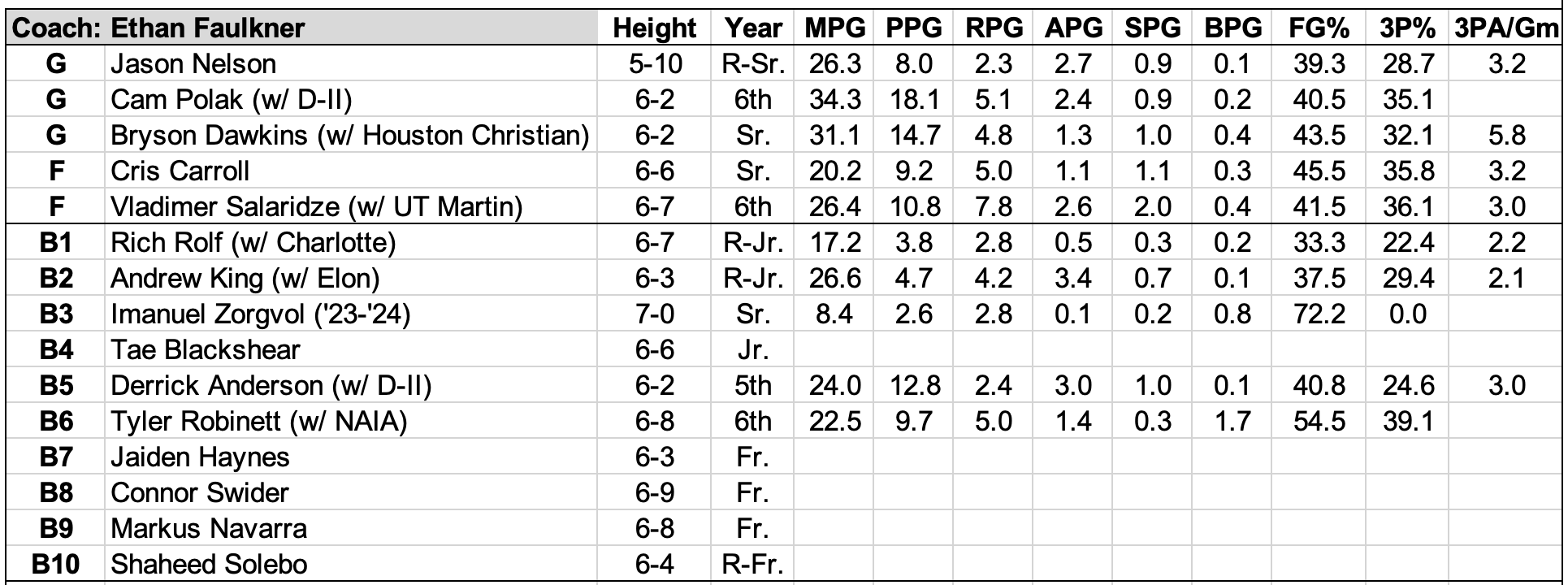
Reasons for Optimism:
It's hard to argue Ethan Faulkner wasn’t the right choice to replace Jerrod Calhoun. His first season was an undisputed success, and could’ve been even better had EJ Farmer been healthy for a full season. Youngstown finished 3-3 without Farmer coming down the stretch (due to a Staph infection), and the Penguins also dropped key games early in the conference slate (against Milwaukee and Cleveland State) after Farmer’s first stint on the IR.
Farmer's unique combination of skill and length from the guard position is something Faulkner wanted to replicate, and duplicate, with this roster rebuild.
We weren't very big from the guard position last year. I think if you come and see our group physically, we look different from the guard position, which I'm really encouraged by. I think that gives us a chance to be even better on the defensive end of the floor as well.
That nugget from Faulkner's media session this offseason may shine a light on the lineup priorities he hopes to target this year. In general, Faulkner is hoping depth is a competitive advantage by keep fresh bodies at the ready and mitigating the risk of injury being concentrated in one or two players.
I think there are 13 or 14 guys that are going to have a chance to compete for minutes. Obviously, we're not going to play that many when it gets right down to it, but we've got a lot of guys that have shown really good signs throughout the summer and into our fall practices.
To replace the lost perimeter production, Faulkner tabbed Cam Polak, Bryson Dawkins and Derrick Anderson, who all put up big numbers at their former stops. Anderson is more of a downhill attacker, Dawkins is more of a shooter / shotmaker and Polak falls somewhere in between, so Faulkner has a well rounded shot diet to play with at the off guard position. Elon transfer Drew King (6-3) isn't an assertive scorer but he's rock solid at everything else. King's ability to play point or slide off the ball will make him a critical glue piece in a myriad of different lineups.
Faulkner clearly bolstered his wing and forward personnel with the additions of Tae Blackshear, Rich Rolf and Vladimer Salaridze. Blackshear was a big time shooter at the JUCO level, and Faulkner is thirsty for a better shooting team this season - thus, he could quickly climb up the rotation depth chart.
Salaridze seems to be the newcomer bubbling with the most potential. The UT Martin transfer is an enticing matrix type swingman capable. He can grab and go off the glass and spark the 'Guins transition attack. He's also a dangerous screener in pick-n-pop or pick-n-roll actions operating out of ball screens.
Faulkner had success transforming a similar prototype in Nico Galette, an inefficient low major player who blossomed under Faulkner's tutelage. As alluring as Salaridze's offensive arsenal is, he was not an efficient scorer or finisher around the rim last year:
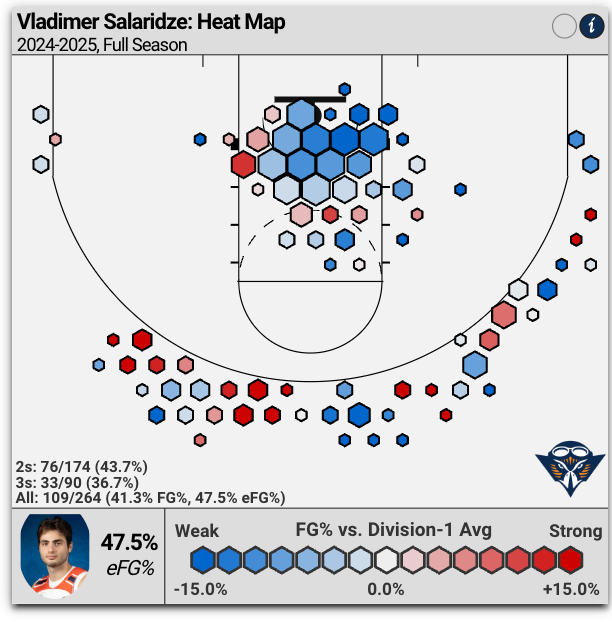
Causes for Concerns:
While Farmer’s injury clearly had a negative impact, the same is true of Jason Nelson’s brief stint on the IR in late November last season. Youngstown dropped three in a row without Nelson over the Thanksgiving break, including the game against Presbyterian when Nelson got hurt.
Nelson played the role of change-of-pace spark off the bench last season but is in line to be promoted to full time starter this season. He’s a blur in the open floor when the game opens up in transition but his shooting woes are harder to hide in half court settings. He’s also been turnover prone at times. Without a surehanded counterpart like Farmer next to Nelson (the hidden component of Farmer’s immense value was that he simply never turned it over), Nelson must tighten up the ball security screws this season in a more marquee role.
The biggest loss of the offseason is Gabe Dynes, Youngstown's monstrous 7-3 scarecrow in side. It’s no surprise Dynes swatted over three shots a game last season, nor is it a surprise that the ‘Guins were a considerably better defensive unit with Dynes on the floor.
The chart below shows Youngstown’s five most frequently used lineups last year (minimum of 50 possessions or more), which featured a blend of Dynes or Cris Carroll at the 5 position.
The encouraging twist from this data is that Youngstown's best lineup was actually with OUT Dynes (playing Carroll as a small ball 5). However, the second, third and fourth most effective lineups featured Dynes on the floor and the worst lineup by a mile when Dynes was on the bench. The key difference between YSU’s best and worst lineup (both without Dynes) was Farmer and Nelson. That's a bad omen given there may be may Nelson and Carroll bookend lineups this season.

7-0 returner Imanuel Zorgvol could be a Dynes-type X-Factor this season. Faulkner confirmed Zorgvol is back up and running after missing all of last season with injury. The other wildcard could be Tyler Robinett, a super senior who blocked two shots a game last season at the College of Idaho.
Bottom Line:
While the loss of Dynes up front is the headlining departure, the loss of Farmer may actually sting more. The Guins are once again deep, old and talented but backcourt loses serious firepower with Farmer, Galette, Harper and Maxey all gone. Still, the Faulkner factor is real, and his ability to harvest talent and chemistry with such a heavy portal reliance deserves the benefit of the doubt.
4) Purdue Fort Wayne
Key Returners:
Corey Hadnot II, Maximus Nelson
Key Losses:
Jalen Jackson, Rasheed Bello, Quinton Morton-Robertson, Eric Mulder, Chandler Cuthrell
Key Newcomers:
Mikale Stevenson, DeAndre Craig, Darius Duffy, Ja'Corey Lipkins
Roster:
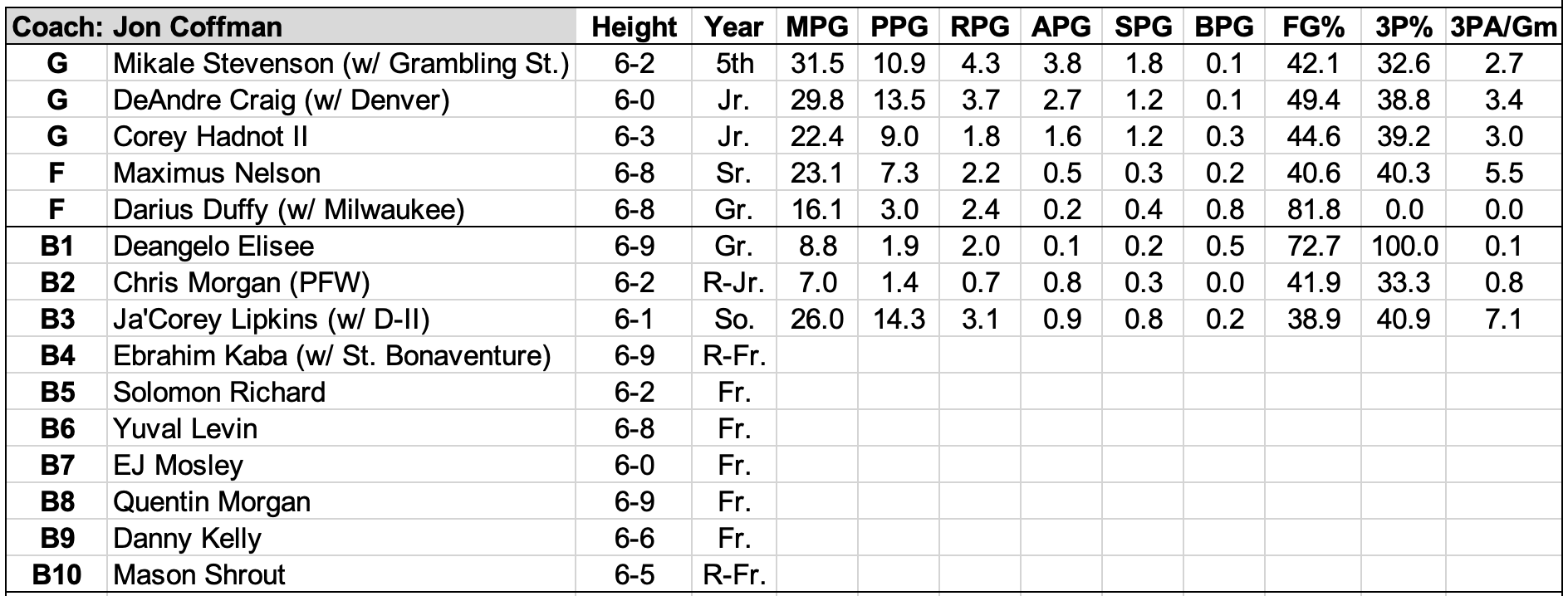
Reasons for Optimism:
Let’s start from the bottom of the depth chart and work our way up. The Mastodons lost superb talent this summer, which not only puts pressure on the experienced newcomers to deliver but also the bench, which is where many mid-majors need to develop depth - and fast…
Jon Coffman is resolute in recruiting the old fashioned way. He brings in two of the best true freshmen in the Horizon, EJ Mosley and Quentin Morgan, who Coffman gushed about on the Center Hub podcast this summer:
We're always going to recruit freshmen. We've had a lot of success with that. You look at John Konchar in the NBA; he was a freshman we redshirted and put on 42 pounds of muscle. You look at Jared Godfrey, our all-time leading scorer; he's another freshman…
We did that again this year. You have EJ Mosley out of Chicago. He has really shown out this preseason and is going to impact winning on the floor. Arguably, he's one of the best point guards out of all of Illinois last year and definitely Chicago.
Then Quentin Morgan, another freshman we found at the NCAA Academy two years ago from Richmond, Virginia. Really talented freshmen. Now, that's an area where we've added some depth, and we're probably longer and bigger than we have been in past years.
Mosley is a diminutive shifty guard who colleague Arman Jovic identified Mosely on his Horizon Freshman of the Year watchlist his mid major newcomer projections early this summer, along with fellow incoming rookie Yuval Levin from Israel. Levin played on the U20 national team with Danny Wolf, so he’s used to playing with high level pros. Coffman made another bet on a rangy skill forward with Ebrahim Kaba, who projects as a potential pick-n-pop weapon on the offensive end. At 6-9, Kaba is effectively a guard in a forward's body.
The upside with Morgan, Levin and Kaba is simply a bonus on this deeper roster - that is, Coffman doesn't need them to produce at a high rate. At minimum, they further reinforce an already stout unit, anchored by mainstays Deangelo Elisee and Max Nelson.
Elisee, when healthy, is a terrific know-your-role garbage man. The ‘Dons have historically been light in the big department, so Elisee brings an important dimension to the mix. Nelson sits on the polar opposite end of the spectrum. He is a see ball, catch ball, shoot ball, one trick pony at 6-8. He’s simply too frail to play the 5 but he can fit like a glove at the 4.
The secret weapon might end up being Darius Duffy, a mid August addition from Milwaukee. Duffy is a reliable rim punisher and shot blocker at the 5. If he and Elisee can stay healthy all year, the Mastodons will be much improved on the back end.
Causes for Concerns:
Despite the improved interior depth, it’s hard to see Coffman veering away from 4-guard lineups. The ‘Dons the deadly ‘shred and spread’ philosophy has created some of the Horizon’s most proficient offenses in prior seasons.
On paper, five proven perimeter players will battle for three spots in the rotation, given the depth and skill intact at the 4. Incumbent Corey Hadnot, a dual threat combo guard, struggled down the stretch last year but he passes the eye test with flying colors. He's skilled, strong and has real bounce to his game, which helped him emerge as a plus defender last season.
Lesser used returner Chris Morgan will also be in the mix for minutes but he might be usurped by Ja’Corey Lipkins, a smooth southpaw shooter with deep range. As the CBBAnalytics.com' shot chart below shows, Lipkins' shot diet at D-II Charleston WV last season was all rim and threes, which jives well with Coffman’s analytic-inspired approach. He needs to finish at a higher clip inside but he was a flamethrower from long range.
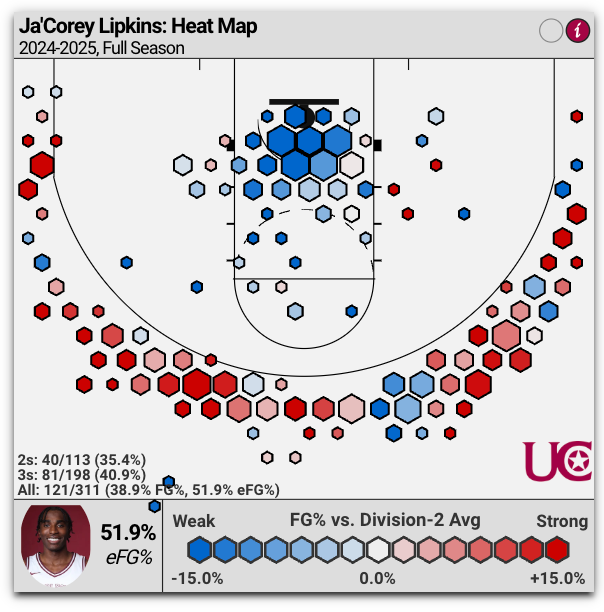
Lipkins might settle into a sixth man super sub role, which would imply a starting perimeter trio of Hadnot, Mikale Stevenson and DeAndre Craig. Despite standing a couple inches shorter, Craig fits better off the ball next to the bigger Stevenson, a tremendous passer at the point of attack. Stevenson may not be an efficient scorer, but Craig’s three-level efficiency offsets that.
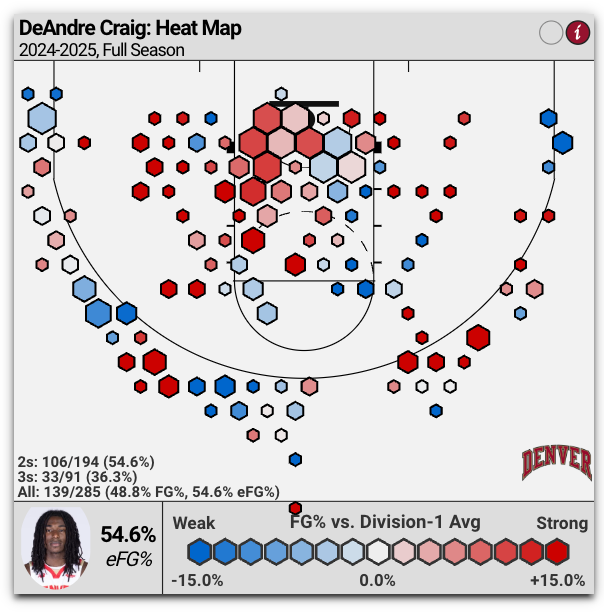
Replicating Jalen Jackson and Rasheed Bello’s efficiency won’t be easy but Coffman is wise to target similar lead guard prototypes in Stevenson and Craig. Per the chart below, this duo generated the majority of their buckets last year on their own (as defined by “FGM UAST%, or percentage of field goals that were unassisted on). For comparison, Jackson and Bello are shown above on the top two lines.

Stevenson and Craig may end up being a watered down version of the Jackson / Bello twofer but are at least cut from that same dynamic prototype.
Bottom Line:
Very few people predicted the Jalen Jackon or Rasheed Bello outbursts coming two years ago when they both took the league by storm in their first season in the Horizon. Coffman is banking on Stevenson and Craig to pick up some of that slack, while leaning on a deeper and more rugged frontline. The ‘Dons may not match last year’s sterling offensive field goal percentages but that should be mitigated by an improved rebounding and rim protecting unit.
5) Northern Kentucky
Key Returners:
Dan Gherezgher Jr., LJ Wells, Sam Vinson
Key Losses:
Trey Robinson, Josh Dilling, Keeyan Itejere, Randall Pettus II
Key Newcomers:
Shawn Nelson, Donovan Oday, Kael Robinson, Tae Dozier, Addison Archer, JJ Apathjang, Ethan Elliott
Roster:
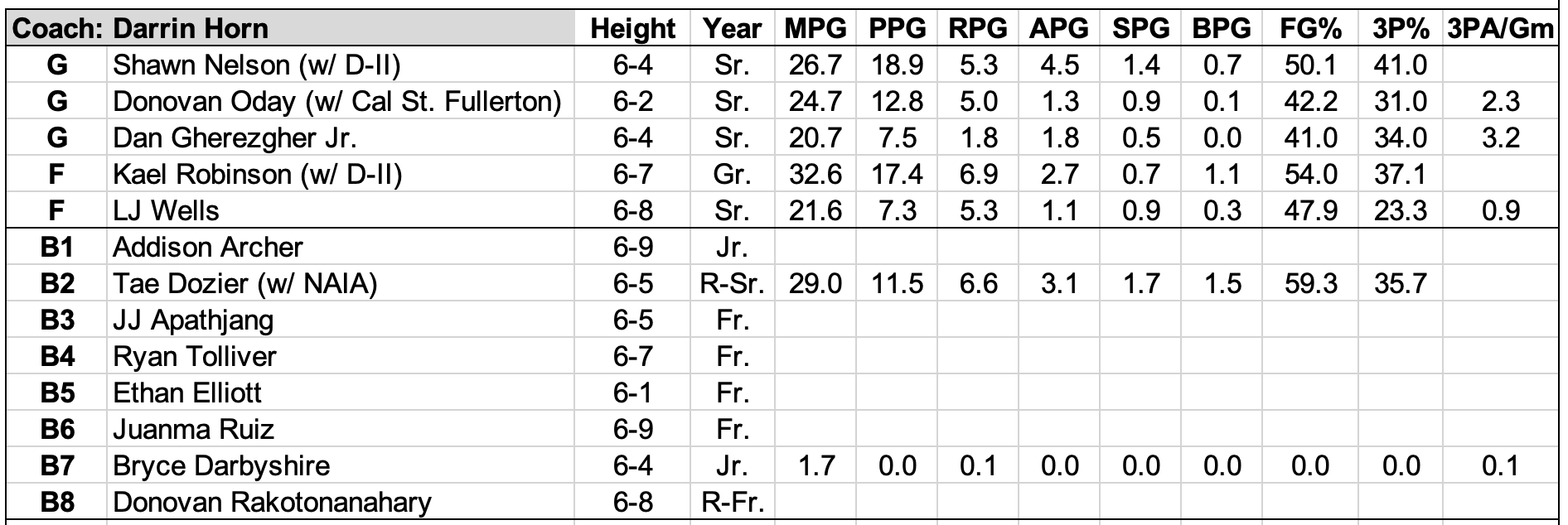
Reasons for Optimism:
Mid-major coaches must be strategic in their allotment of ‘re-recruitment’ effort. Darrin Horn and his staff wisely made Dan Gherezgher a top priority after his incendiary explosion in February.
This screenshot from KenPom encapsulates the correlation between Gherezgher’s insertion into the starting lineup and the Norse late season surge last year:
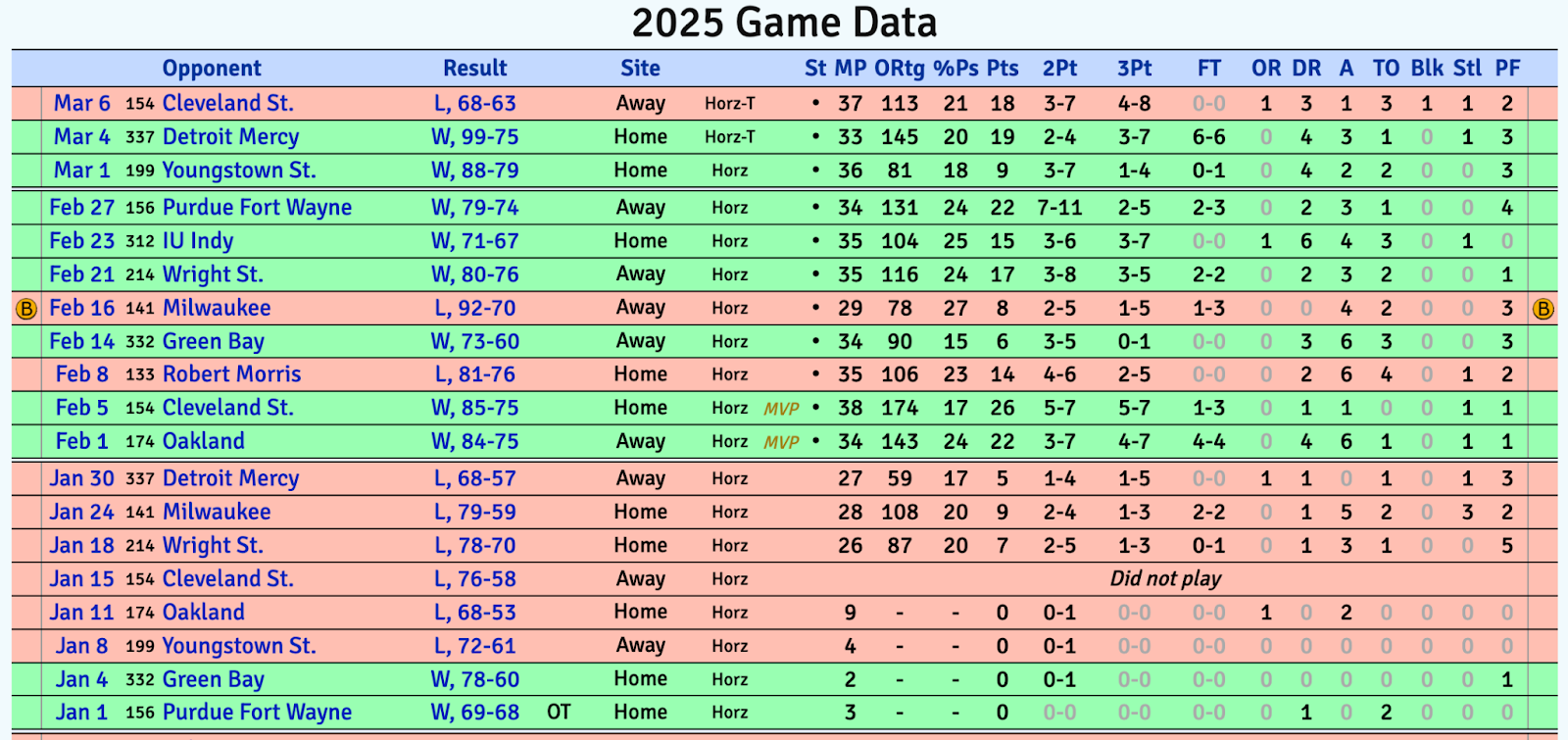
Fellow returner LJ Wells was the man whose spot Gherezgher took in the starting lineup. This decision benefitted Wells, too, as he played far more consistently down the stretch coming off the bench. Wells is a beast on the boards and a versatile, rugged forward - though, a tad undersized for a prototypical 5-man.
Horn is hoping his rebounding initiatives can be aided by better rebounding guards, which is true of newcomers Shawn Nelson and Donovan Oday. However, their offensive production will mean everything to this year’s team. The Norse backcourt was gutted by the portal and graduation this summer, leaving this year's crop a little light in that department.
Nelson brings a winning pedigree from D-II Barton, where he flashed as an elite midrange shooter and adept facilitator as a true alpha lead guard.
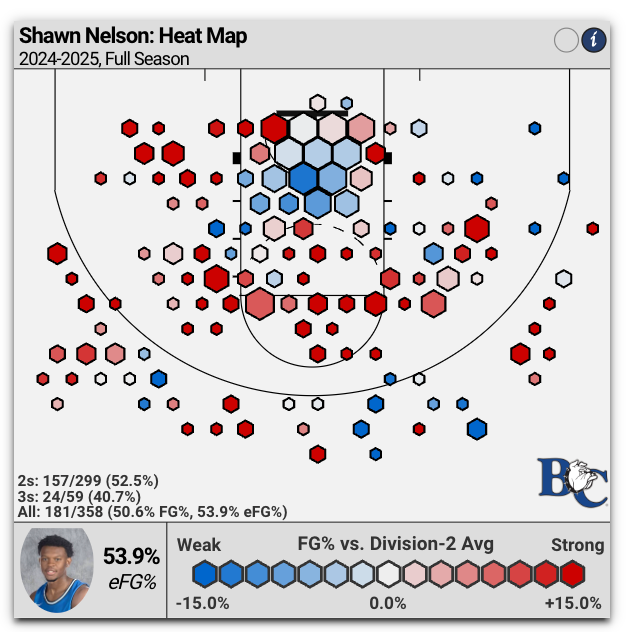
However, there’s a heavy burden on his plate as the roster currently stands (Vinson waiver pending), so Horn is betting on a big bounce back campaign from Oday, who looked far more comfortable in a complementary role two years ago at Fullerton. His efficiency plummeted last season under duress of a watered down supporting cast. At minimum, he’s an explosive athlete and potential pest defensively.
Causes for Concerns:
Replacing Sam Vinson from both a production and intangible perspective is tough. Vinson was denied on his first attempt at a medical waiver to play one more year and is now pushing through the appeals process. Obviously if he gets cleared, that blows up the entire outlook of this preview.
Vinson’s two way impact is unrivaled by anyone in the league. His offensive efficiency dipped a tad last season, a byproduct of the residual injury rust from the year prior, but he finally found his stride late in the season.
Notice the stark gap in Vinson’s on / off net rating impact, courtesy of CBBAnalytics.com, between his overall seasons (top) and his last 10 games (bottom), when he looked much more like himself.
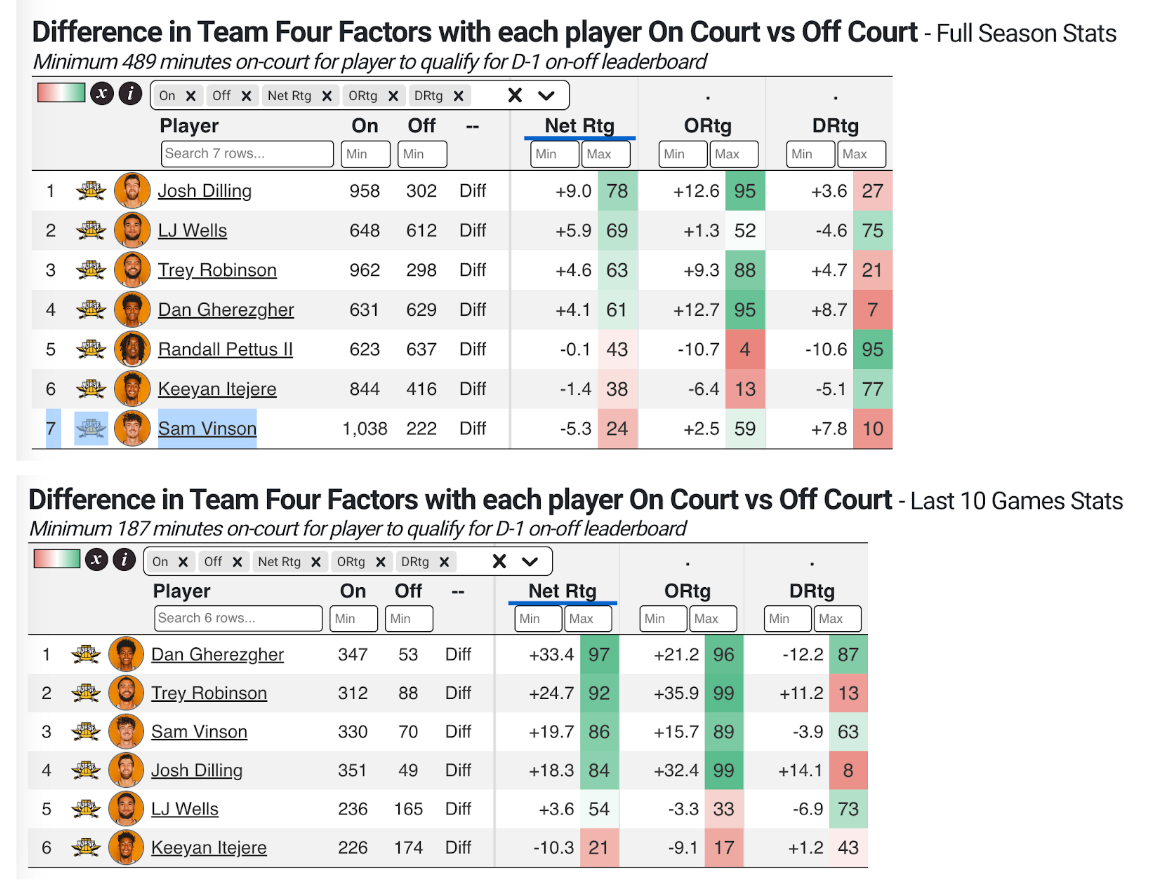
Keep an eye on Ethan Elliot, an Australian rookie who could slide his way into the starting point guard spot. He profiles as a 'mini Vinson', equipped with outstanding vision as a handler and disruptive anticipation as a defender (which should fit nicely in Horn's scheme).
The Norse stuck to Horn’s defensive script and leaned heavily on their patented 2-3 zone last season (deploying it on nearly 70% of all defensive possessions, per Synergy). In conference play, their defensive efficiency graded out as pedestrian by Horizon standards, a noticeable dip from their standard the three years prior. The main problem was defending the 3-point line, where opponents canned 37% of their attempts. Rebounding was another sore spot, on both ends of the floor for that matter.
This is where Wells is pivotal. Without him, the rebounding production would suffer. Rim protection is less of a concern in this scheme, and Wells held his ground ably two seasons ago, when he played more frequently at the 5 spot (last year, he was more of a 4).
The Norse's depth will be put to the test as well. Horn scoured through NAIA, D-II and JUCO talent pools to bolster his bench.
- 6-5 Tae Dozier profiles as a jack of all trades utility man. Dozier was a stat sheet stuffer at NAIA Georgetown college a year ago
- 6-7 Kael Robinson is a super skilled forward from New Zealand. His playmaking could open up new attacking dimensions on offense. Between Dozier, Robinson and Nelson, the Norse’s downhill drivers could be potent
- 6-9 Addison Archer likely plays a key reserve role behind Wells up front. He's skilled and polished offensively but presumably a downgrade to Wells' defense when he comes in
Bottom Line:
The Norse's ceiling this season feels high, stemming from the potential impact of the newcomers. That said, there are certainly big shoes to fill. If the new arrivals can master the zone mechanics on the defensive end and weaponize their uniqueness on the offensive end, NKU should clear the .500 hurdle in league for the seventh consecutive year. However, a podium finish feels like a lofty goal given the roster uncertainty.
6) Wright St.
Key Returners:
Solomon Callaghan, Logan Woods, Michael Imariagbe, Andrea Holden
Key Losses:
Brandon Noel, Alex Huibregtse, Jack Doumbia, Keaton Norris
Key Newcomers:
Dominic Pangonis, Bryan Etumnu, Sam Alamutu, TJ Burch, Michael Cooper
Roster:
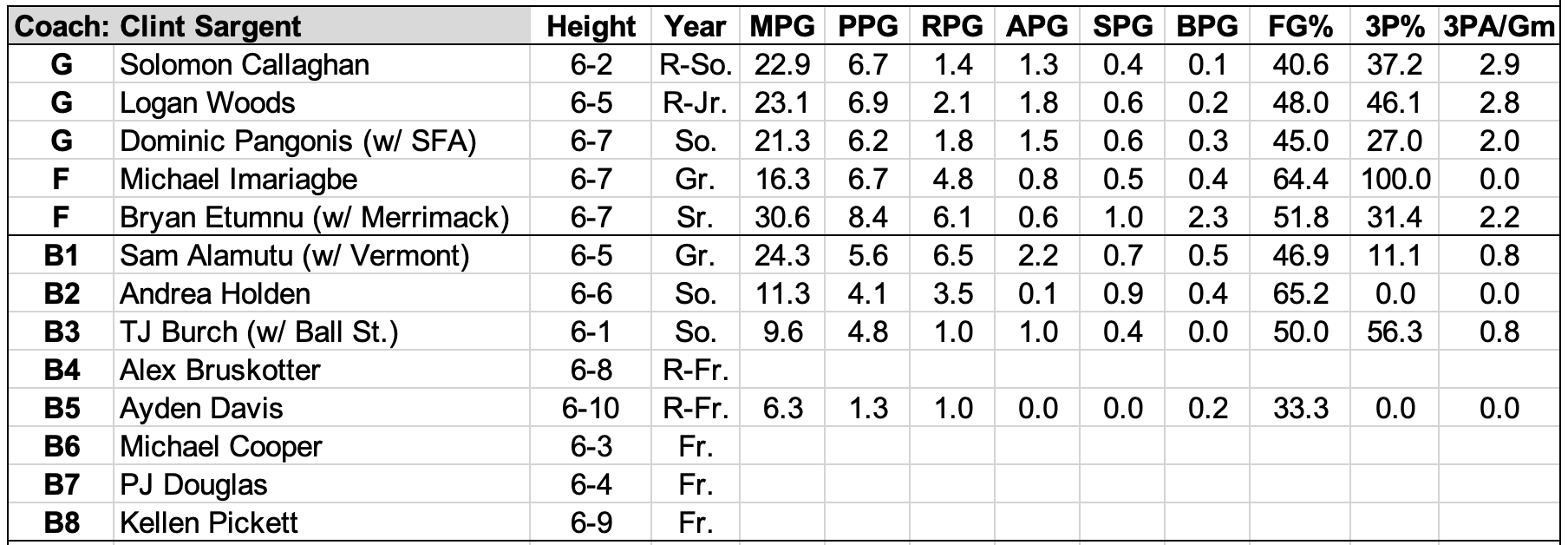
Reasons for Optimism:
Clint Sargent is going back to the drawing board on defense. It’s been a recurring Achilles heel for Wright State basketball, and, devoid of a nationally elite offense to compensate, the Raiders fell to an unfamiliar place in the Horizon standings last season.
Part of it is personnel, which we’ll address in a second, but excellent reporting from the Dayton Daily News illuminated just how serious Sargent was about correcting the defensive dilemma.
“I bothered so many people, bombarding them with questions. Ben McCollum at Iowa — I picked his brain — Cleveland State’s coach (Rob Summers) and Rob Senderoff at Kent, just to name a few,” Sargent said. “Guys were really gracious with their time. Plus, there were a few international coaches who I really like how they teach ball-screen coverage, how they pick up the ball. We’re trying to be something different based on our personnel.”
The personnel shake up should help as well. An additional year of seasoning for Michael Imariagbe and Andrea Holden should do wonders, but the addition of Bryan Etumnu completely flips the script.
To clarify, rebounding was not the root issue last season (WSU finished 2nd in defensive rebounding rate among Horizon teams, per KenPom). The glass will be a certified calling card of this team again this year with Imariagbe and Holden expected to see increased run. They are both beasts on the boards with physical frames and an uncanny nose for the ball.
The revelation could be replacing Brandon Noel with Etumnu as the interior defensive quarterback. Noel was simply not an impactful rim protector, which is where Etumnu thrives. Despite standing a couple inches shorter than Noel, the reigning MAAC Defensive Player of the Year is an explosive, twitchy athlete who terrorized NEC and MAAC rim attackers the last two seasons. And while he’s no Noel on offense, he can make face up threes and finish on pick-n-roll dives.
Merrimack F Bryan Etumnu will enter the transfer portal, @noah_reisenfeld and @Adie_vongontard of @YMAPAAsports tells TPR.
— The Portal Report (@ThePortalReport) March 19, 2025
The 6-7 Junior averaged 8.4 points, 6.4 rebounds, and 2.3 blocks per game this season!
Reigning MAAC DPOY! pic.twitter.com/bD9sRLtedX
Vermont transfer Sam Alamutu is another elite rebounder in a wing’s body. Given the proven rebounding prowess in house, Alamutu’s production almost feels redundant but his switchability as a defender on the perimeter should come in handy. He’s also fairly reliable with the ball in his hands on offense, though, shooting remains an issue. The final defensive piece to this new puzzle is seldom used 6-10 big Ayden Davis. While he has a contingency plan this year, Davis offers a prototypical 5-man build should it be needed in an emergency.
Causes for Concerns:
It’s been a decade since “shooting” or “shotmaking” falls under the question mark category for Wright State. Incumbents Solomon Callaghan and Logan Woods likely get the keys to this offense after deferring to Keaton Norris and Alex Huibregtse last season. Norris and Huibregtse were robotically efficient as co-pilots of the offense, which Woods and Callaghan benefitted from. Sargent is embracing the 2025-26 attack to be a by-committee effort but that doesn’t absolve Woods and Callaghan from new responsibilities as ball handlers and initiators.
Callaghan could end being the straw who stirs the drink. He’s simply a more well rounded and fluid player, though maybe not the prolific shooter that Woods is. Last season, Callaghan did plenty of scoring damage on his own account, compared to Woods, whose baskets were generally assisted on (per chart below, 68% of his field goals were assisted, compared to 53% for Callaghan):
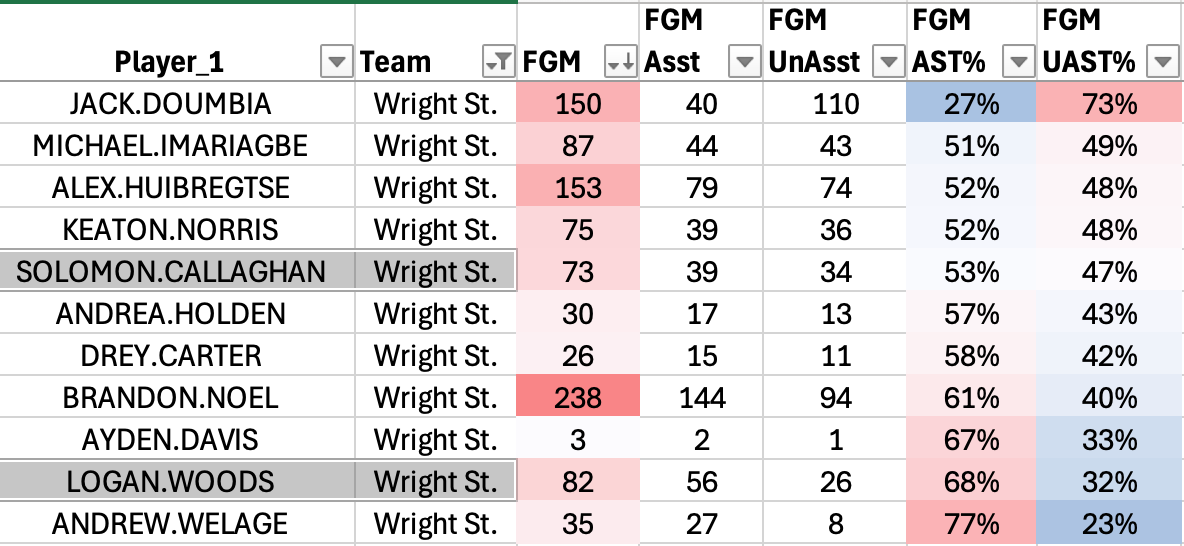
Dominic Pangonis, TJ Burch and lauded rookie Michael Cooper round out the rest of the newcomers. Burch could be a diamond in the rough after showcasing impressive two-way impact in last year's limited run at Ball State. Pangonis is a 6-7 swingman who possesses moldable tools to be a jack of all trades type weapon on the wing. However, Cooper might be the ace up Sargeant’s sleeve this season. On tape, he looks like this team’s most polished offensive scorer and playmaker, and this defensive-tilted roster may need his offensive pop.
Bottom Line:
The ultimate challenge for coaches in the portal era is striking a balance between correcting last year’s flaws without sacrificing last year’s strengths. It may seem like Sargent over invested in defense but there’s hidden versatility and skill here, which might be the secret sauce in finding equilibrium to the Raiders’ attack in 2026.
7) Robert Morris
Key Returners:
Ryan Prather Jr.
Key Losses:
Alvaro Folgueiras, Amarion Dickerson, Josh Omojafo, Kam Woods, D.J. Smith, Ismael Plet
Key Newcomers:
Albert Vargas, Cam Wilds, DeSean Goode, Nikolaos Chitikoudis, Josh Hill, Kaleb Brown, Ta'Zir Smith, Jeremiah Littlejohn
Roster:
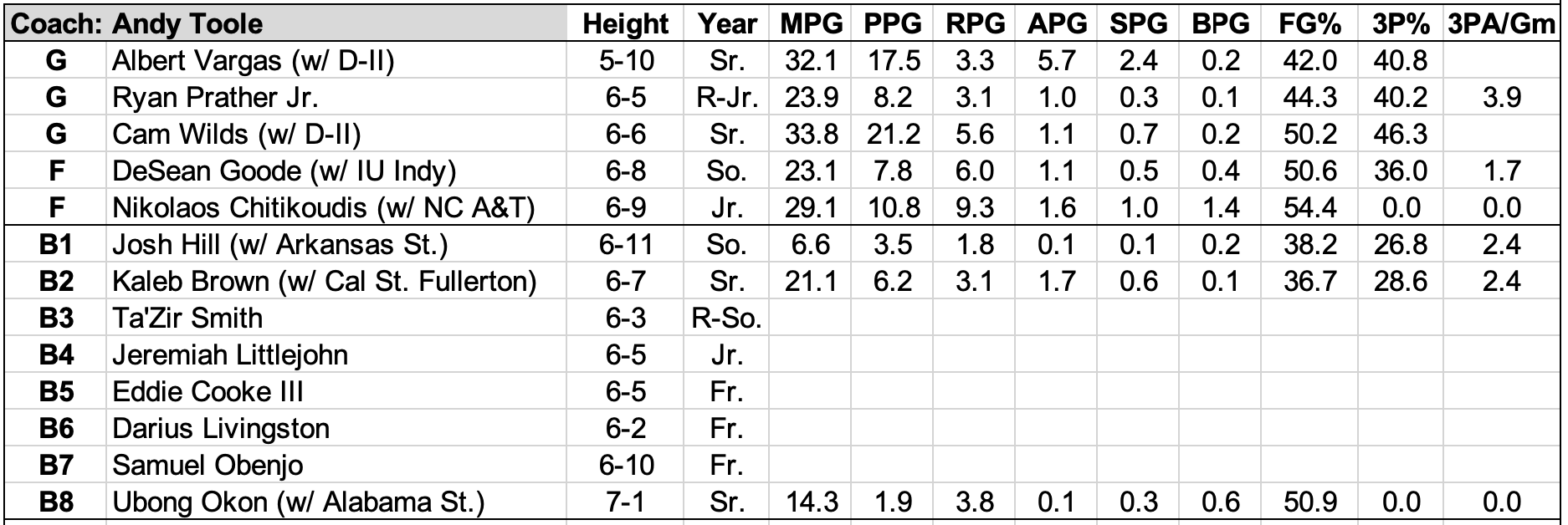
Reasons for Optimism:
Make sure to check out the entire AMA thread with Andy Toole from this offseason (for Basket Under Review subscribers)
Building off last year’s momentum is no longer a thing at the mid-major level. You win, you get hunted in the portal, and then you rebuild, or reload. Andy Toole is no stranger to this game of musical chairs. Still, topping last year’s bar is a tall order.
Speaking with Toole this summer, he spoke on the new opportunities this revamped roster presents. Specifically, a well stocked supply of scoring and shooting, and guards that excel in the open floor, may lead to more early offense in transition.
“We may try to play faster but I always say that,” said Toole, chuckling.
In Toole’s defense, Bobby Mo did push the pace at a higher clip last year than Toole’s prior seasons It does make sense, since that’s one way to free up open looks for the Colonials only returning player, Ryan Prather, a sharpshooting two guard who finally found his footing after a year at Akron.
This team desperately needs a table setter to feed Prather, among others, on offense. In steps Albert Vargas, a clear cut floor general from Southern Connecticut State (D-II). Vargas posted a 2.3 assist-to-turnover ratio last year, per CBBAnalytics, while making 40% of his threes, many of which were from way downtown. He will struggle to finish inside but he can stretch the defense with range to set up his drive and dish game off the bounce.
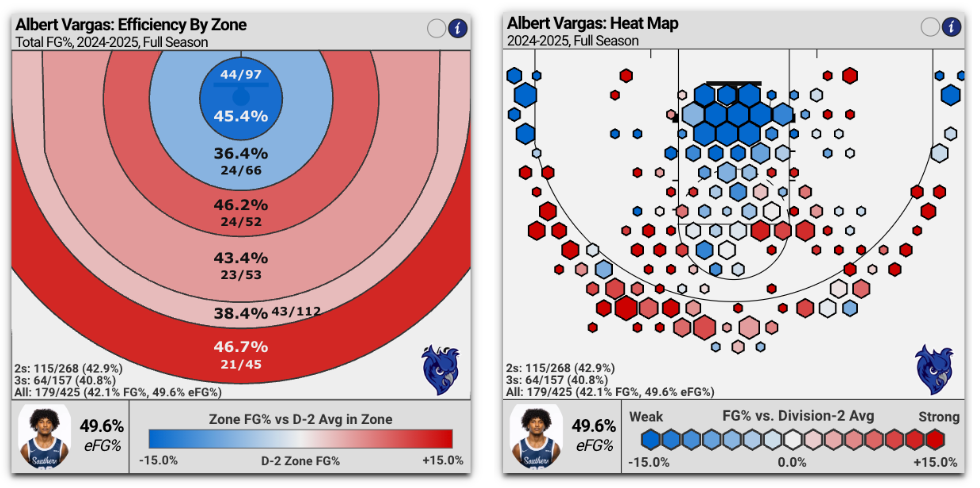
Toole was quick to mention rookie Darius Livingston as a sneaky solid pickup capable of cracking the rotation early. He’s lean but longer than the 5-10 Vargas, and could cement himself as an overqualified backup behind Vargas.
Top-100 JUCO addition Jeremiah Littlejohn is another high upside shooter / scorer who needs work in the weight room to fulfill his potential. He’s got a buttery shotmaking and playmaking bag but Toole won’t crown him major minutes until he proves himself worthy on the other end.
The final wildcard to the backcourt mix is Taz Smith, who profiles as a feast-or-famine sparkplug off the bench. Toole likes his potential as a defender and pop as a scorer.
Causes for Concerns:
The impetus for Bobby Mo’s boon last season was a dynamite frontline, which now undergoes a wholesale makeover. The key is striking the right balance between defensive physicality and offensive skill because finding two way stalwarts of Alvaro Folgueiras’ caliber is tricky.
Of the newcomers, Nikolaos Chitikoudis is the foundational replacement piece up front. The Chitikoudis is a prototypical Greek big with a nose for the rim on the glass, and sound defensive instincts as a defender. While his on / off impact at NC A&T is skewed by a poor supporting cast, it’s clear Chitikoudis is a monstrous difference maker on that side of the ball.
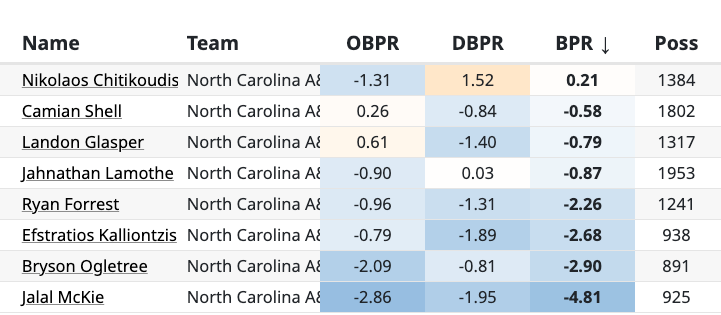
Ideally, Toole can harness more from Chitikoudis on the offensive end, where he’s proven to be a proficient passer out of the post. He still struggles to finish consistently, though, and remains a porous liability from the free throw line.
The rest of the frontline is fairly skilled across the board, which could pair nicely with Chitikoudis at the 5. There’s no better example than inverted forward Josh Hill, a lethal streaky sniper at 6-11. However, at 200 pounds soaking wet and still a relative baby by today’s college experience standards, there’s still work left to do in rounding him into a reliable night to night contributor. He’s worth the upside for Toole, as he can swing a game on his own when he’s dialed in and possesses the unteachable measurables to be a disruptive rim protector down the line.
Two other key forwards, Desean Goode and Kaleb Brown, must work their way back into shape after missing a good portion of the summer, but they are virtual locks to be in the rotation. Both are versatile tools-y skill hybrids that can be molded into various ways offensively. Goode was in the mix for Horizon FOTY
The biggest splash, however, might come from Cam Wilds, a proven bucket getter and dogged defender - Toole thinks he might pop as one of the best perimeter defenders in the league, and evolve into more of a ‘3-and-D’ swiss army knife at this level. Unlike some of the other early developmental additions, Wilds is built like a grown man. He’ll be an immediate help on the glass, too.
Bottom Line:
It’s a brand new operation for Toole, who must try to sustain last year’s momentum without any of the pillars back for 2025-26. He signed numerous undervalued assets from various places in hopes of backfilling the production but it may take time to gel. The bookends, Vargas and Chitikoudis, must stay healthy, while the hybrid wing / forward brigade must bring the physicality and toughness left behind by Amarion Dickerson and Josh Omojafo.
8) Detroit Mercy
Key Returners:
Orlando Lovejoy, TJ Nadeau, Nate Johnson, Legend Geeter, Ryan Kalambay, Jared Lary
Key Losses:
Emmanuel Kuac
Key Newcomers:
Ayden Carter, Tyler Spratt, Jekel Cotton, Lance Stone, Zak Abdalla, Keshawn Fisher
Roster:
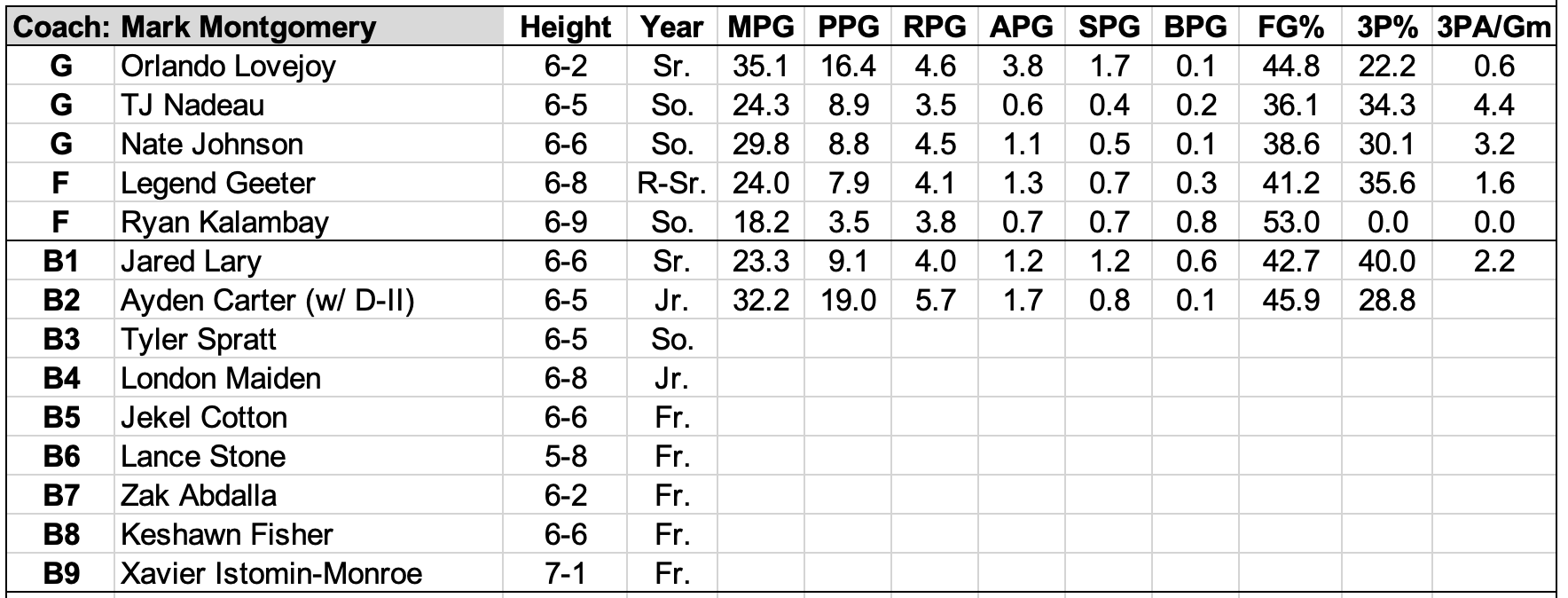
Reasons for Optimism:
The unique bond and affinity for DETROIT BASKETBALL has made a world of difference for Mark Montgomery and his impressive player retention heading into year two. Per BartTorvik’s early projection of Horizon League rotations for the upcoming season (which he cautions is far from precise), the Titans bring back more production from last year than any other team, and it's not that close.
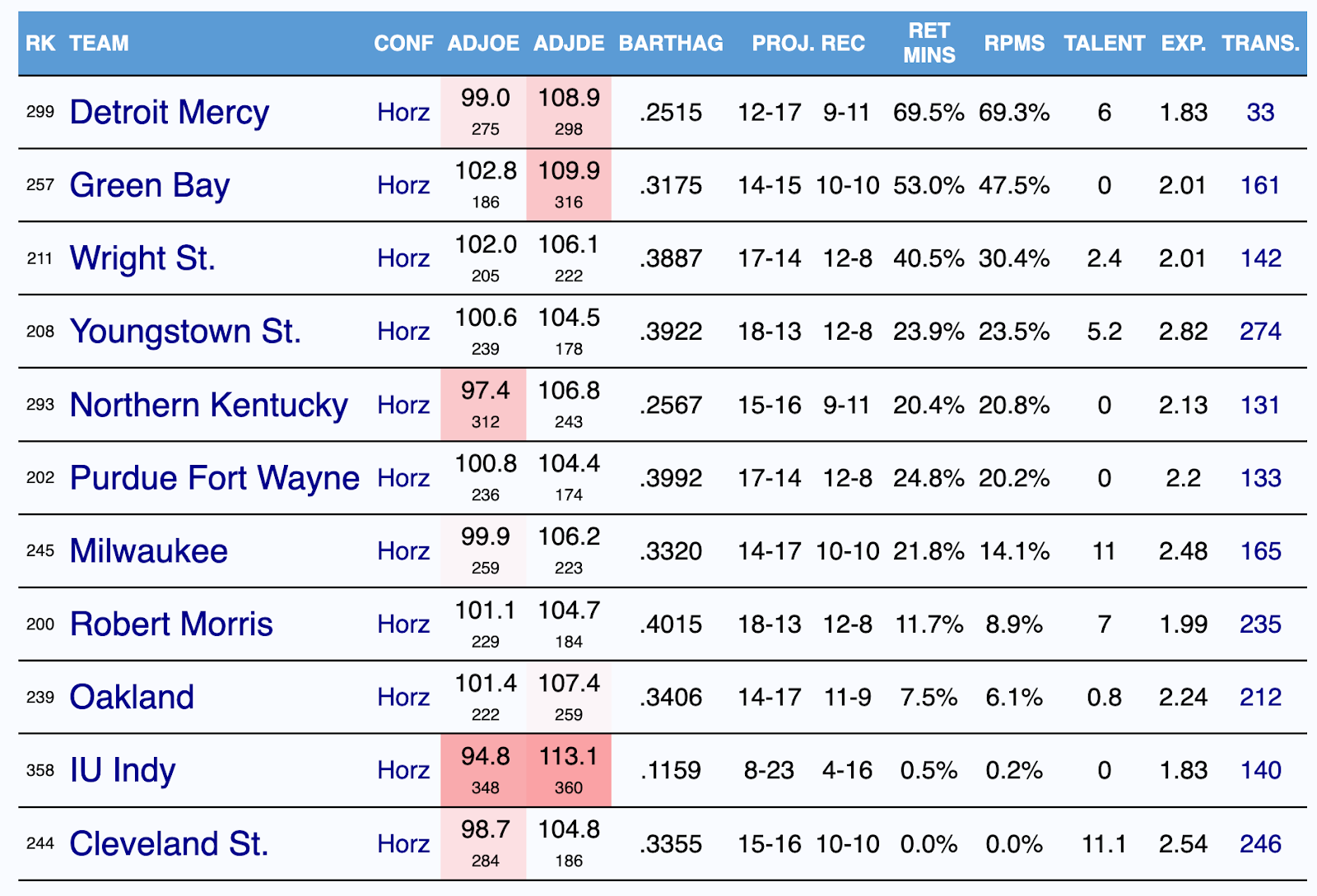
It all starts with the head of the snake, Orlando Lovejoy. I still recall Stan Heath gassing up Lovejoy to me over the phone when prepping for the Eastern Michigan preview a few years ago. Turns out playing on a team with Emoni Bates, Noah Farrakhan and Tyson Acuff stunted a few opportunities for Lovejoy to shine.
Many devout data dudes will vomit at Lovejoy’s shot chart. At 6-3, he loves to find his comfort zone into the 12-18 feet area and shoot over his defender. He may never be a hyper efficient lead alpha but he graded out in the 66th and 70th percentile in paint and mid range 2-pointers, respectively, per CBBAnalytics.com. It's also worth noting Lovejoy's upward pointing trajectory. He improved demonstrably from the non-conference to conference chapters of the season, as the side by side shot chart breakdown shows below:
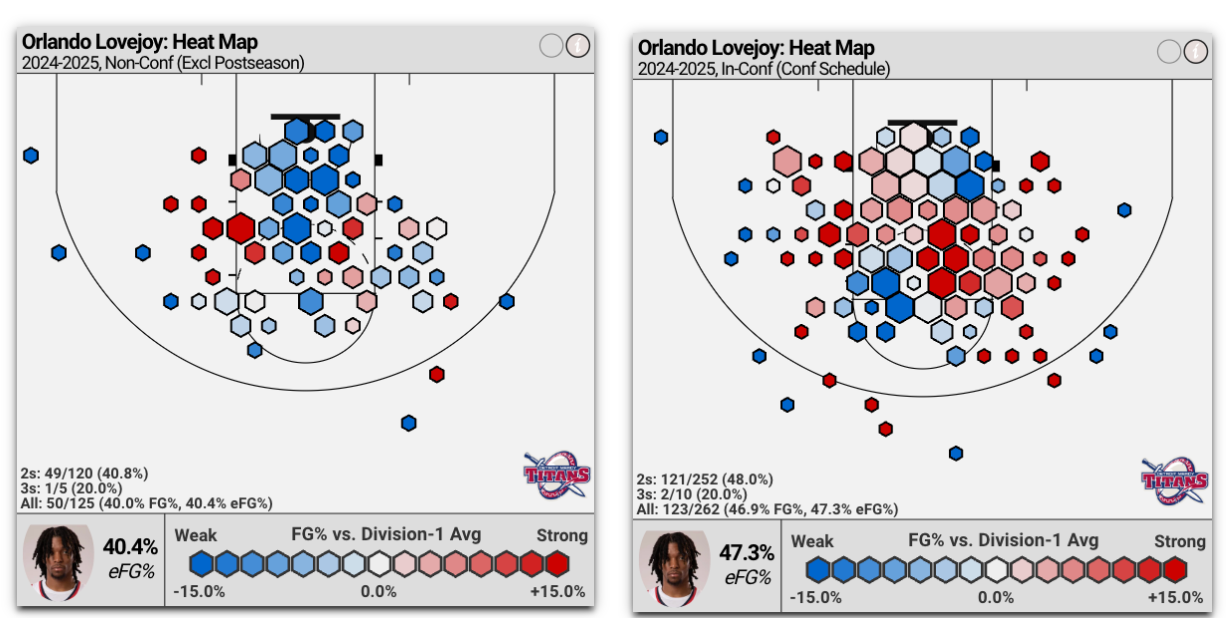
Lovejoy's dogged defense is the tone setter for this gritty Motor City squadron. While the Titans' offense totally went off the rails in conference play last year, the defense hung tough and helped weather the avalanche of injuries that piled up.
Ryan Kalambay is in store for a big jump in his second full season of college ball. Anchoring a defense as a green rookie is a tall task, but Kalambay was thrown to the wolves early out of necessity. Kalamby’s length, strength and motor inside should make him a formidable paint policeman this season.
Fellow veteran forward Legend Geeter fits neatly at the 4 next to Kalamby. Like Lovejoy, Geeter found greener pastures at Mercy after transferring in from EMU. Monty is giving him freedom to expand his range, which could manifest in a useful pick-n-pop weapon on higher volume this year. JUCO newcomer London Maiden will serve as a useful backup to Kalamby as another big bodied space eater in the middle.
Causes for Concerns:
Between the point and the paint, Mercy is well stocked with guards, wings and hybrid forwards. TJ Nadeau, Nate Johnson and Jared Lary are known incumbents, while experienced newcomers Ayden Carter and Tyler Spratt offer additional upside and optionality. Oh, and the rookie class is among the Horizon's best on paper.
If you squint hard enough, there may be monumental jumps in store for this group. If this offense is to be lifted out of the gutter - per KenPom, Mercy finished dead last in offensive efficiency last season by a wide margin - these supporting pieces need to complement Lovejoy’s mid range heavy diet.
This is where Nadeau’s floor spacing gravity is critical - without him, Detroit could’ve built a mansion with their 3-point bricklaying. He made 36% of his 97 threes in league play, but that still couldn’t offset the rest of his teammates’ atrocious shooting.
The ShotQuality.com and Haslametrics.com snapshots below are almost unhinged by today’s modern shot diet standards. However, it's hard to fault Detroit's reliance on midrange jumpers given that's the only area they were somewhat comfortable scoring the ball (most of this is driven by Lovejoy):
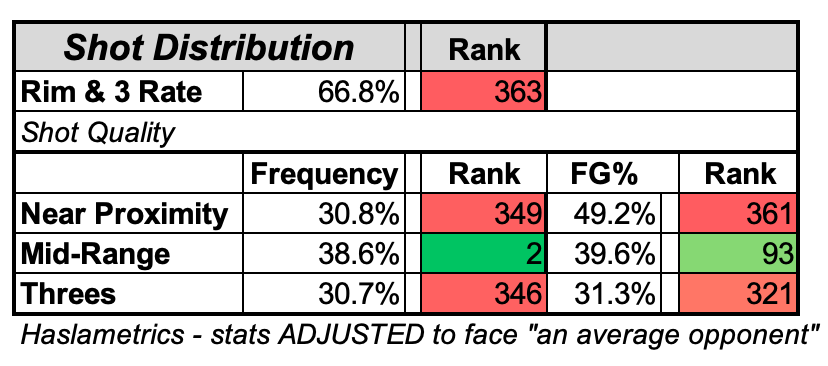
Jared Lary was a pleasant surprise last season until an ACL injury cut his campaign short. It's still a mystery as to what his role will be on this year's roster but he is regarded as a very good shooter . As a bonus, he also graded out as the Titans’ best all around defender, per EvanMiya’s DBPR metric, despite only playing 300 possessions last season:
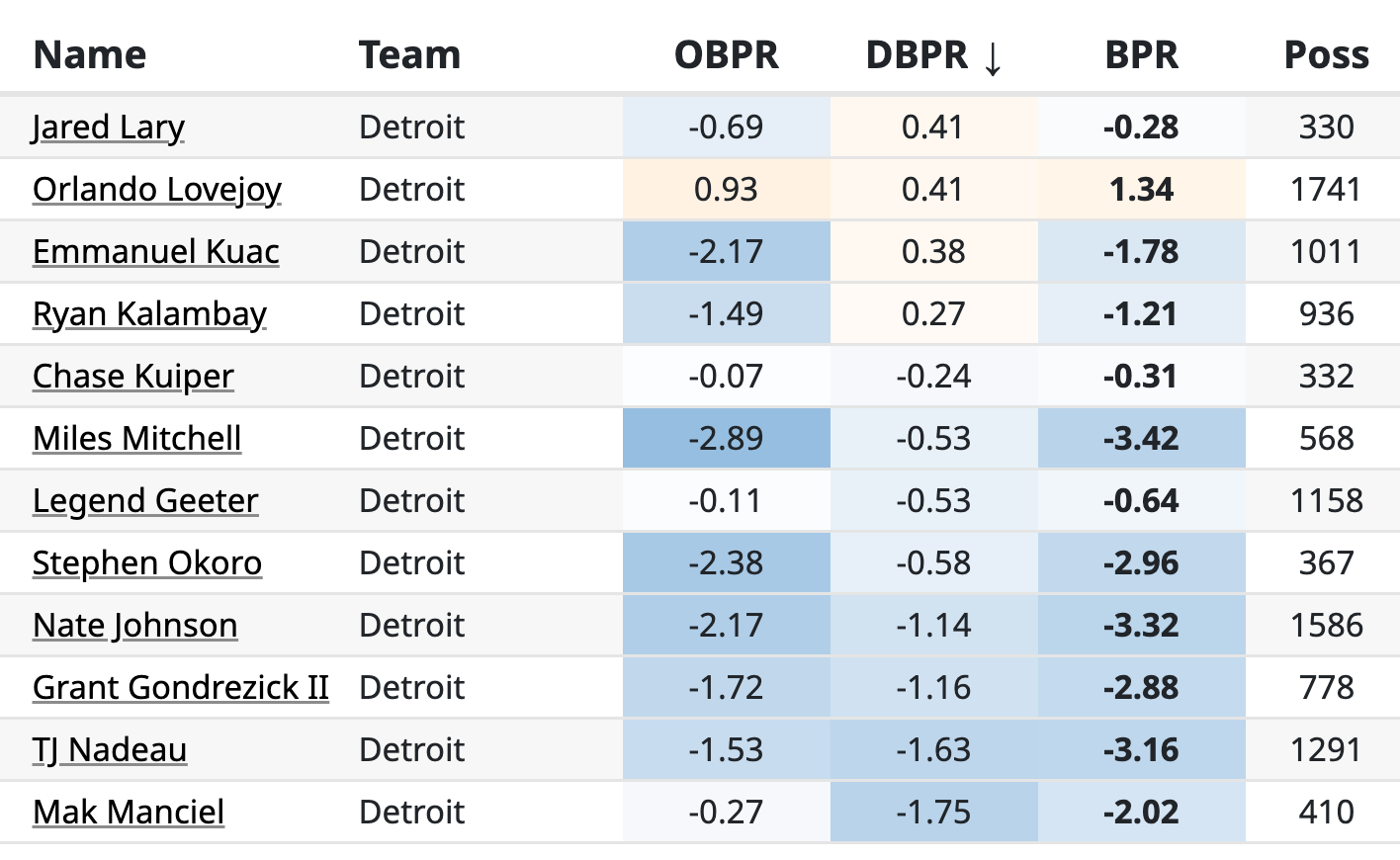
Nate Johnson is another enticing talent with untapped potential. He probably should’ve never played as much as he did last season, but those growing pains should pay dividends this year. It appears he's still growing as well, so there's real 'late bloomer' upside in Johnson on the wing.
From the rookie ranks may rise a couple of budding stars as well. Keshawn Fisher is the rookie to circle this year. The former Overtime Elite prospect is great at nothing but very good at everything, and may turn into a lockdown wing defender in time. Fisher was a finalist for Defensive Player of the Year at OE last season, while posting a well rounded 11.0 points, 5.3 rebounds, 3.4 assists, 1.9 steals and 1.1 blocks a game.
Jekel Cotton, another 3-star prospect, is the other freshmen to track after turning heads at the EYBL Peach Jam. This team will need his shooting early and often. Finally, Ayden Carter projects as a fungible plug-and-play utility man. He dominated the D-II circuit last year (granted, his Walsh team finished 11-15).
Bottom Line:
A clean bill of health would be justice for Montgomery and this Mitten-state laden roster. They deserved better last season after a feisty start to the season. The goal is a deeper, injury-proof roster that will mitigate any sharp downward spirals this year. Defensively, the Titans should be stout but the offense must find a way to operate in harmony with Lovejoy, an unorthodox lead guard due to his high volume mid range chucking tendencies.
9) Cleveland St.
Key Returners:
None
Key Losses:
Tevin Smith, Dylan Arnett, Tahj Staveskie, Chase Robinson, Je'Shawn Stevenson, Ebrima Dibba, Reece Robinson, Jalin Rice
Key Newcomers:
Ice Emery, Tre Beard, Foster Wonders, Josiah Harris, Dayan Nessah, Kamari Jones, Kevo St. Hilaire, Jaidon Lipscomb, Lucas Burton, Holden Pierre-Louis, Manny Hill
Roster:
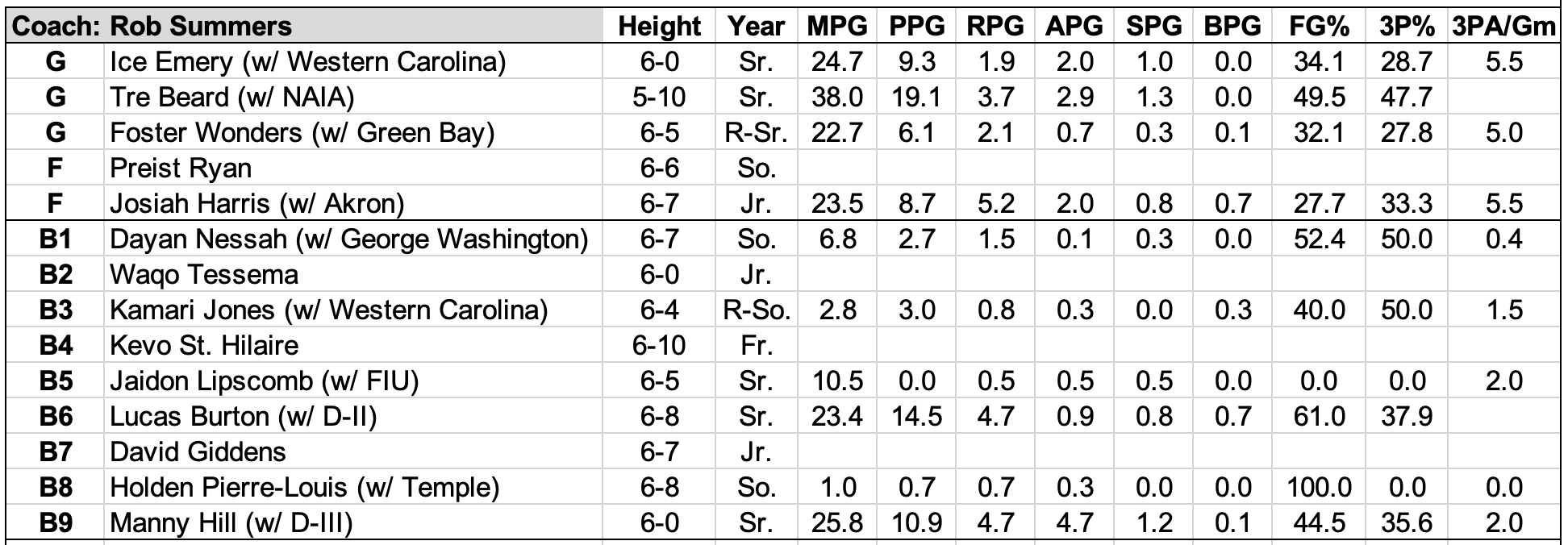
Reasons for Optimism:
Yeesh, this is an intimidating preview to write. Frankly, I have no idea how to organize this roster depth chart, which is a mash up of D-I, D-II, D-III, JUCO and NAIA newcomers.
To start, Rob Summers ushers in a new era of Cleveland State basketball after another successful regime under Dan Robinson’s watchful eye. Robinson built on the foundation laid forth by Dennis Gates, Summers’ friend and former boss at Mizzou - alas, it all comes full circle.
Expect to see many Dennis Gates-isms shine through in Summers' style here. Gates has proven to be a nimble schematic adapter, as seen in his evolution from Cleveland State to Mizzou. Summers should take a page out of Gates’ playbook at CSU by deploying strength in numbers. It’s debatable that every scholarship player could weasel their way into the rotation by the time Horizon play rolls around, which points to the optionality value Summers has in this year one upstart.
The other strategic tenant in Summers' reboot was experience, a lesson Gates passed down to Summers, as described on the Horizone Roundtable’s extensive league preview episode:
One thing that Coach Gates really taught me well when I was here the first time around was this is an older league. You have to get old, stay old. He said, "You got to have some guys with dirt on their fingernails." It's not a league for a lot of freshmen, a lot of young guys to come through. It's been a junior college league for the longest time, and now with the portal, you really have to get older guys that understand the physicality and how tough this league is from top to bottom.
Summers welcomes five upperclassmen D-I transfers to this messy recipe, and four are safe bets to play high leverage minutes. Foster Wonders is a familiar face from Green Bay who had big moments during the Phoenix special season two years ago (it seems like the world forgot about him last year). As a lights out shooter, Wonders may flourish in a faster system. Summers isn’t shy about divulging his quest to open up the offense with tempo and 3-point shooting.
On the wing, the athletic and versatile Josiah Harris could be a sleeping giant from Akron. Harris was terrific early on last year, including a 16-point performance at Saint Mary’s and a 13-point / 7-rebound effort at Arkansas State in the season opener. However, a shoulder injury ruined his season abruptly, so he'll need to stay healthy this year.
Former WCU teammates, Ice Emery and Kamari Jones, are potential starter candidates in the backcourt and could factor in the point guard / lead guard and shot creation equation, as could FIU defector Jaidon Lipscomb. Lipscomb’s track record, isolating his 2023-24 season at FIU, looks like the most reputable of the bunch (part time starting experience in the CUSA is hard to find at this level). Lipscomb is armed with a wiry 6-5 frame - he can create, shoot and defend at the point of attack.
Tre Beard (NAIA) and Manny Hill (D-III), along with three JUCO newcomers - David Giddens, Waqo Tessema and Priest Ryan - will also toss their hat in the ring for minutes right away. Beard and Tessema are two prolific shooters who must be marked on the perimeter, while Hill and Ryan are more downhill attackers. Giddens carries the strongest pedigree of the bunch as an honorable mention JUCO All-American. Summers sees Giddens as one of their best all-around defenders, so look to see him 'size up' and play 4 and even 5 in smaller lineups.
The most lauded incoming talent is undeniably Dayan Nessah, a late blooming stud from George Washington. He exploded on the international scene before testing the waters last year in DC. Sadly, he never found a rhythm in the A-10, largely due to injury and illness.
Dayan Nessah has been one of the best surprises in this year's FIBA U19 World Cup.
— Bracket Busters (@BBustersHoops) July 3, 2025
Through four games:
- 17.3 points
- 9.3 rebounds
- 4.8 assists
- 1.3 steals
The 6'7 forward had minimal playing time as a freshman at George Washington last year, but he entered the transfer… pic.twitter.com/u7Q3tr8OIp
Causes for Concerns:
Size is typically not a major concern in the Horizon, a league that’s mostly dictated by guards and wings. Rookie Kevo St. Hillaire is the only player above 6-8 on this roster.
The obvious remedy is creating turnovers, which was Gates’ secret sauce to success in 2021 and 2022. The Vikings also mixed and matched defenses those two years, another curveball Summers might consider deploying this season - per Synergy, Gates played zone on 25% on all defensive possessions in 2021-22, the season preceding his move to Mizzou.
However, that team also boasted Deante ‘Spider’ Johnson, a freakish leaper and long-armed disruptor who covered up a lot of perimeter gambling and risk taking.
This is why Harris might be an indispensable cog in this year’s machine. He was once a key part of a Bob Huggins’ coached team at West Virginia before bouncing over to Akron. He’s certainly undersized as a 5-man but could still be disruptive as a multi-positional defensive quarterback. Perhaps Lucas Burton is able to size up and play some 5, but I remain skeptical of the Vikings’ defensive options outside of Harris.
Make sure to read Jordan Majewski’s far more nuanced breakdown of CSU’s outlook under Summers’ tactical blueprint
Bottom Line:
Should Summers find disruptive and unique ways to mask the lack of size and length up front, this could be a Deja Vu of Dennis' Gates breakthrough season in 2020-21. There's talent, skill and depth up and down the roster, and a potential sleeping giant in Nessah. Devoid of a clear pecking order or proven system, the Vikings may have the element of surprise working in their favor.
10) Green Bay
Key Returners:
Preston Ruedinger, Marcus Hall, Mac Wrecke, CJ O'Hara
Key Losses:
Anthony Roy, Yonatan Levy, Jeremiah Johnson, Foster Wonders, Ben Tweedy, Ryan Wade
Key Newcomers:
LeBron Thomas, Ramel Bethea, Justin Allen, Rob Stroud, Maruan Cicic
Roster:
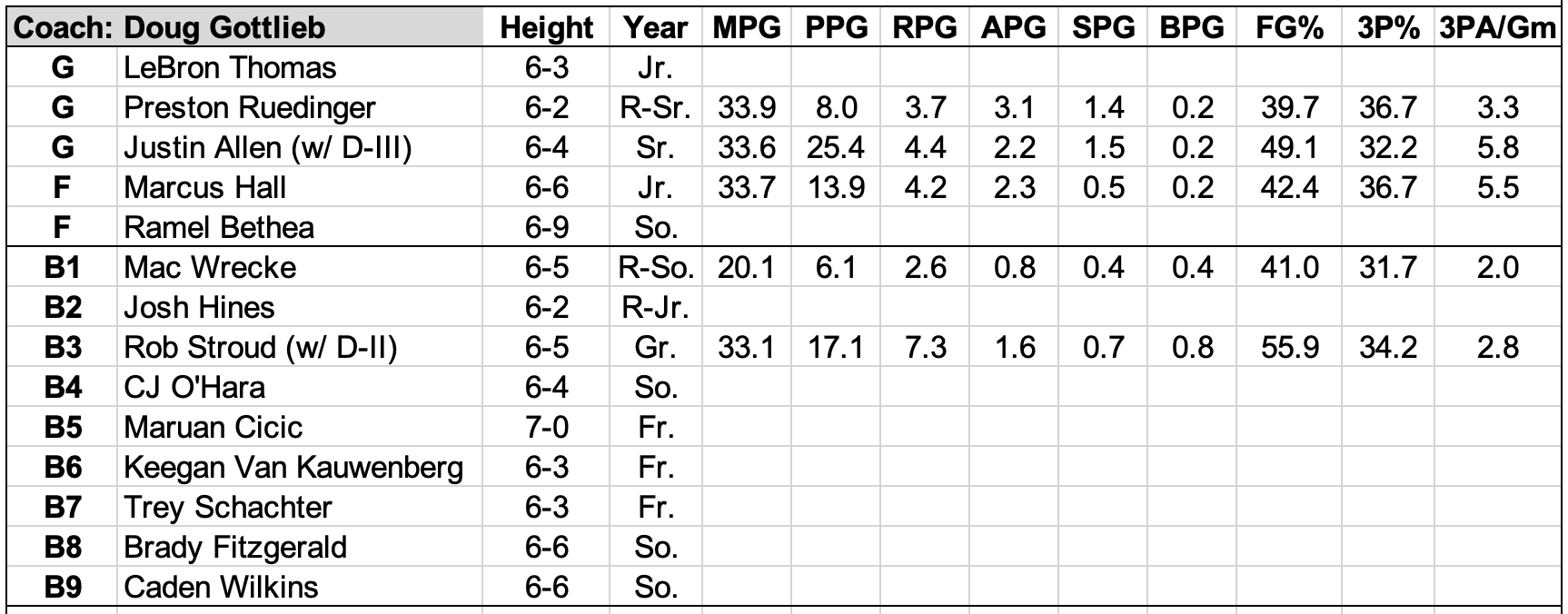
Reasons for Optimism:
Doug Gottlieb caught plenty of strays from naysayers last summer with his ambitious quest to coach a D-I basketball team and host a radio show simultaneously. Well, it wasn’t a great start for Gottlieb's defense team.
With only one direction to go in year two, Gottlieb identified the root causes of last season’s shortcomings. The Phoenix were just too young and too frail, marketably outclassed from a talent and athleticism standpoint. The injuries didn't help, nor did the lingering distraction related to Anthony Roy's suspension.
The players Gottlieb retained this summer are intentionally in sync with his revamped vision of an older, more mature, and generally grittier team. The heart and soul of this squad is Preston Ruedinger, a legitimate ‘Rudy’ esque hustler who does a little bit of everything. His motor and smarts are useful, but he's not an alpha dog scorer or high usage shot maker on a winning team.
With all due respect to 'Rudy', Marcus Hall and Mac Wrecke are the returners who move the needle offensively. Wrecke is a sturdy wing with a knack for burrowing his way to the rim, while Hall is the leaner, longer shotmaker. Their scoring versatility is valuable but their roles were stretched too far as focal points of the offense last year.
CJ O'Hara had a lightbulb turn on late in the year, coinciding with Green Bay's vastly improved performance over the last three weeks of the season. O'Hara was especially productive on the offensive glass and was, frankly, a lone wolf in that department.
Gottlieb's infusion of new blood to reset the pecking order is intriguing. Top flight JUCO prospects LeBron Thomas and Josh Hines. For Green Bay to make a move in the standings, Thomas needs to make an emphatic splash this year. Hines was actually more productive last season but at a lower JUCO level, which warrants skepticism as to how that will translate as a high usage contributor. Thomas, however, looks D-I ready now.
Thomas, a big southpaw playmaker, loves to get downhill off the dribble, either out in transition or from the top of the key in the half court. His destiny might be the Phoenix’s dual threat lead guard, capable of steering the offense while being assertive as a scorer as well. He’s simply too talented and too athletic to keep the restrictor plates on, especially with some shot creation limitations around him:
Incoming Vincennes Sophomore LeBron Thomas is name to watch
— Arman Jovic (@PDTScouting) September 30, 2024
LeBron had a strong freshman season for Vincennes where he averaged 16/4/4 on 44/36/79 splits. He was one of the most productive Juco freshmen in the nation this past season
Thomas has solid positional size for a PG… pic.twitter.com/h8MvU1f1wM
Justin Allen is a fascinating case study. A dominant D-III season at Carnegie Mellon drew interest from a myriad of other mid-major suitors but Allen ultimately chose Green Bay.
The same is true of Rob Stroud, but he did his damage at a strong D-II program, Lewis. With his size, length and agility, Stroud looks like a multi-positional defensive tool Gottlieb wanted - don’t be surprised to see him slide up and play some forward in smaller lineups.
If Gottlieb desired experience and defense, he hit the lottery in 29-year old - yes, you read that right - Ramel Bethea, regarded as one of the best defenders at the JUCO level last season. Bethea served multiple years in the Navy, thus, delaying his eligibility clock and unlocking a potential defensive cheat code for the Phoenix.
MiraCosta College (JUCO) transfer Ramel Bethea has committed to Green Bay.
— Arman Jovic (@PDTScouting) May 15, 2025
After Ramel graduated HS in 2014, he grew from 6’3” to 6’9” and has a 7’4” wingspan.
Post HS he enrolled in the Navy and served multiple years in the navy.
This past season he enrolled at MiraCosta… pic.twitter.com/XvcD3Klk9h
If Bethea doesn’t pan out, Maruan Cicic might be a darkhorse Horizon Freshman of the Year candidate. The Phoenix beat out Iona for the 7-footer, who was productive on the younger Eurobasket circuits.
Causes for Concerns:
Gottlieb looked in the mirror this summer as far as his own and his staff’s experience, or lack thereof...
“We didn't have anybody on our staff who coached in the league, so you learn about the league, right? That's different. This level is different because of the guarantee games and some of the scheduling quirks that come with it. We didn't have anybody who had been at Green Bay. So, what are each of these trips like? And then for me personally, not coaching a college game in my life, even when I helped out at Oklahoma State, I wasn't allowed to be on the bench. So, suggestions that you make, it's very, very different. I would guess I'd be much better. And then I've surrounded myself with more experienced staff. I think that's important as well.”
He hired Keil Ganz and Kerry Rupp as new assistants, plus Andy Ground as a special assistant to the head coach. Rupp and Ground are certified veterans, with more than five decades combined coaching experience at the collegiate level. Rupp cut his teeth under the great Rick Majerus back in the Utah glory days, while Ground turned a lowly Saddleback JUCO program into a low level powerhouse five years ago (he cozied into a local high school assistant in Southern California since then).
One might argue their sharpest days are behind them but a fresh slate of ideas with unmatched experience can only help Gottlieb, as will another year in the conference.
Injuries and general team health also could torpedo this campaign again. Ruedinger is the highest injury risk of the group but even returners Hall and Wrecke, who draw a ton of contact at the rim, could easily suffer a setback as well. Thus, its imperative Gottlieb sticks to his script of building depth to keep the floor more stable than it was last season.
Bottom Line:
Gottlieb may have stumbled into some serious talent with the JUCO and international additions this summer. There’s still a steep learning curve for most of these new faces but the upside for a Horizon League spoiler is there from a talent perspective. If healthy, Gottleib may finally be on a level playing field from a Jimmy and Joes lens - which means he’; really be under the microscope on the Xs and Os.
11) IU Indy
Key Returners:
None
Key Losses:
Paul Zilinskas, Jarvis Walker, Sean Craig, Alec Millender, DeSean Goode, Keenan Garner
Key Newcomers:
Kyler D'Augustino, JP Dragas, Jaxon Edwards, Finley Woodward, Aiden Miller, Kameron Tinsley, Corey Boston, Matt Compas, Reece Hagy, Maguire Mitchell, Gabe Stewart, Micah Davis
Roster:

Reasons for Optimism:
Welcome to “The System”...
As detailed in robust depth by Sam Federman in an earlier summer deep dive, IU Indy’s unexpected coaching shake up paves the way for an ‘air raid esque’ offensive attack coming to a gym near you.
Please read that breakdown for deeper intricacies of what made Howlett’s go-go offense wildly successful at the D-II level. For this preview, here’s the key pillars of the personnel Howlett needs to make it work in the majors.
As Howlett discussed on the Horizone Roundtable’s extensive league preview episode, the transfer of culture should be semi-seamless aided by the West Liberty holdovers that came with him.
I was lucky enough to bring over four of my players from West Liberty from last year's roster, and then two guys that were committed to me at West Liberty also joined me. So they were helpful in bridging the gap there with style of play.
I wouldn’t bet on a Ben McCollum type explosion in his first season in D-I but that continuity parallel is notable. In terms of player prototypes, Howlett targets extreme versatility. He’s talked about converting bigs into guards to acclimate their skillsets to play with the pace and space required. To keep the pedal to the metal, fresh bodies are also mandatory, so expect 10 to 11 players to see the floor on a nightly basis.
The backcourt tandem of Kyler D'Augustino and JP Dragas form a symbiotic ‘playmaker’ and ‘shooter’ tandem. D'Augustino, the unquestioned engine of this offense, excels at getting to the rim, while Dragas is the one you can’t leave open from the outside. D'Augustino was ice cold from behind the stripe last year but he's clearly a better than 30% gunner from 3-point range.
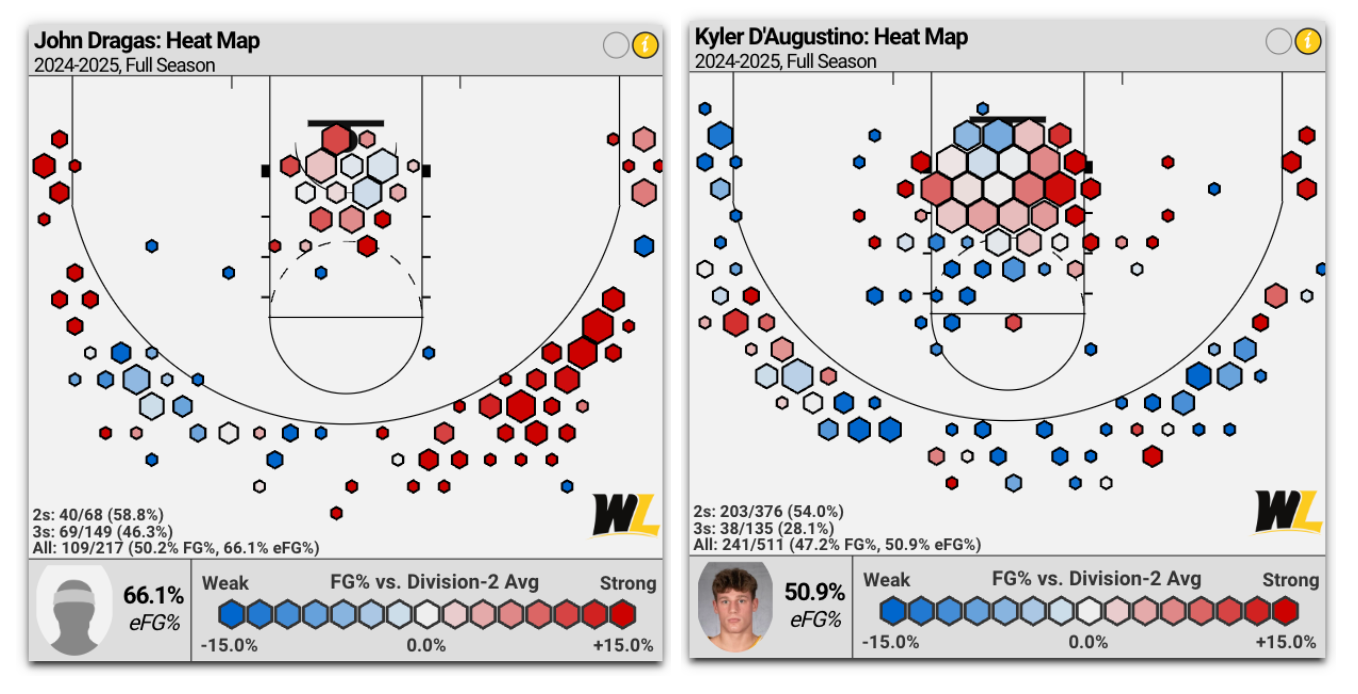
D-II Concord transfer Corey Boston brings a turbo jet gear to this backcourt and should make an instant impact on both sides of the ball. Howlett faced off against Boston numerous times at his prior stop. Expect D'Augustino and Boston to key Howlett's pressure defensively.
None of these three unique guards are pure point guards but that’s where Finley Woodward’s crisp interior passing comes into play. The English native is a reliable inside out hub through which this half court offense can operate when fast break chances aren’t immediately available. Woodward’s sharp passing is topped only by his robotic decision making. Over his last 12 games of the season last year, Woodward dished out 66 assists while only turning it over 12 times. On the year, he posted an insane 4.9 assist-to-turnover ratio.
Kameron Tinsley rounds out this roster jigsaw as a floor spacing wing. Like Dragas, Tinsley is automatic from downtown and, at 6-6, rangy enough to help cover up defensive miscues on the back end. The question is how Howlett deploys Tinsley and Woodward positionally. Last season, Howlett did not play them together very often, but their skillsets do seem to complement one another.
Causes for Concerns:
Of the eight proven performers joining the army this year, St. Bonaventure Jaxon Edwards and NAIA transfer Matt Compas must make a dent in this rotation, particularly on the defensive end. Edwards’ is a freak athlete at the guard position and could morph into a demon defender in Howlett’s pressure front. Compas is cut from that same cloth but is even bigger at 6-4.
Howlett was wise to attack quick twitch athletes in the portal to supplement his ‘returners’. The screenshot below is West Liberty’s team stat page from a year ago. This contextualizes what Howlett ‘lost’ from his 30-5 team a year ago. Notice that Howlett’s most disruptive defenders all graduated (notably JJ Harper, Lanyc Shuler and Dante Spadafora, not highlighted in green boxes):
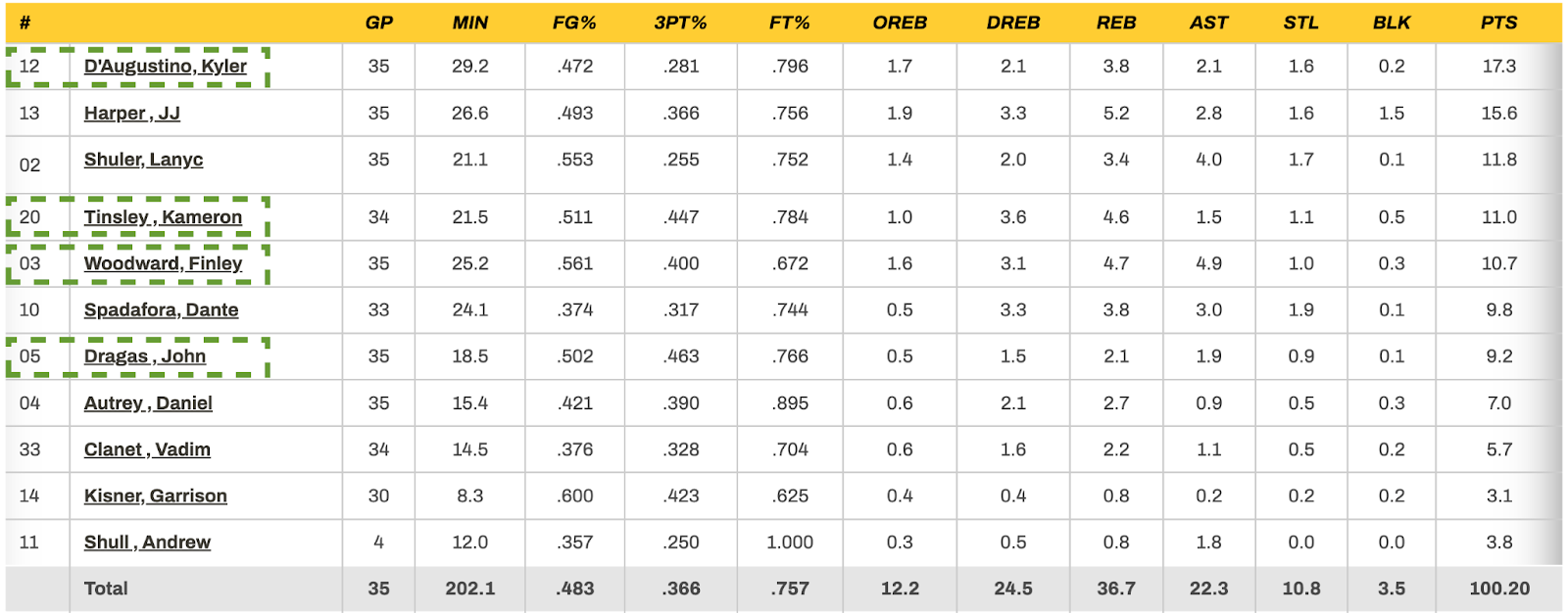
Aiden Miller was another key addition up front to help bolster the interior size. His Point Park team was not great last season but his individual impact was enormous on the defensive side of the ball. Miller’s shot blocking prowess translated directly to the bottom line - his team surrendered 13 points fewer per 100 possessions when he was on the floor - but time will tell if that translates to this level.
Rookie Gabe Stewart is the other potential X-Factor up front. Stewart brings size and a proven track record as a rim protector in high school but, again, this is a gargantuan step up in class.
Bottom Line:
IU Indy will be fast, fun and frenetic - but how effective will ‘The System’ be in year 1? Howlett’s a razor sharp tactician, not a gimmick promoter, so I would bet on some subtle tweaks to optimize his personnel to this competitive landscape. He also invested in athletes on the perimeter to help bring his chaotic defensive scheme to life. The question is will these newcomers invest in the rigorous conditioning it takes to make this system work?

